Tippit Part 4
In the next portion of this essay I will discuss how Oswald's behaviour changed as he came to realize that he was being framed for murder. His repeated requests for legal help were ignored and thwarted by Capt. Fritz who repeatedly told the press that Oswald could have whatever lawyer he wanted.
Capt. Westbrook said that around 2:03 PM, ten minutes after HARVEY Oswald was arrested, he got into a car with Sergeant Stringer that was driven by patrolman Roy L. Gross. Westbrook said that he notified the police dispatcher, "Notify my office, I'm en route, will you?" Westbrook would have arrived at police headquarters around 2:10 PM.
2:00 PM When HARVEY Oswald arrived at police headquarters there was a tremendous amount of people on the 3rd floor of City Hall and in Fritz's office. Oswald was asked if he wanted to cover his face from reporters. Oswald said, "Why should I ? I haven't done anything to be ashamed of." Officers Hill, Bentley, Walker and McDonald were told by Lt. Baker to take Oswald across the hallway to burglary and theft. Bentley gave Oswald's arrest wallet to Lt. Baker and went to the personnel office to fill out an arrest report.

Oswald was left in the room with Officer Walker, who asked, "Now, what is your name?" He replied, "My name is Lee Harvey Oswald. "Where do you work?" Oswald said, "Texas School Book Depository." Walker asked,"Why did you kill the officer?.....Did you kill the officer because you were scared of being arrested for something?" Oswald looked a Walker and said, "I am not scared of anything. Do I look like I am scared now?" Walker remembered that Oswald did not look like he was scared. Oswald was calm, and he was not a bit nervous.
Hill takes the .38 revolver to Westbrook's office
Sgt. Hill returned to police headquarters and brought the .38 revolver taken from HARVEY Oswald to Westbrook's office. This gun should have been taken immediately to Homicide and Robbery, but Hill brought the gun to the personnel office. Why? The gun allegedly taken from Oswald in the theater remained in Capt. Westbrook's personnel office for the next hour. This .38 revolver, allegedly used to murder Tippit, was then initialed by police officers in Westbrook's office, circa 3:15 PM, given to Homicide and Robbery, and turned over to the FBI later that evening. I say this .38 revolver was "allegedly used to murder Tippit," because we will never know, and will never be able to prove, whether or not this particular gun was the murder weapon. We don't know where, when, or how HARVEY Oswald obtained the revolver that was taken from him in the theater. We don't know who, when, or if this revolver was given to Oswald. For example, was the .38 revolver used to murder Officer Tippit by LEE Oswald given to a contact in the theater and then given to HARVEY Oswald in the theater? Was HARVEY Oswald given a .38 revolver when he was driven from his rooming house to the theater? Did HARVEY Oswald pick up the .38 revolver from his rooming house while changing clothes? Did the police plant this .38 revolver on Oswald? And we don't know if the .38 revolver allegedly taken from Oswald at the theater and placed in Capt. Westbrook's office was somehow switched for the .38 revolver used to murder Officer Tippit.Gerry Hill told the Warren Commission, "a few minutes later Captain Westbrook came in the office and said that our suspect had admitted being a Communist. This is strictly hearsay. I did not hear it myself. And at about this point Captain Westbrook suggested that I change the heading of my report to include Oswald as the name of the suspect in the assassination of the President and in the murder of Officer J. D. Tippit, which I did.... I left it with the captain to be typed."
Capt. Westbrook, head of the personnel department, involved with the Tippit murder, the 2nd Oswald wallet, and with the framing HARVEY Oswald for the Tippit murder, was now telling Sgt. Hill to include Oswald in the arrest report charging him with the murder of President Kennedy.
Around 2:15 PM, Capt. Fritz, Det. Boyd, and Det. Sims returned from the Book Depository to police headquarters. Boyd told the Warren Commission that he and Sims moved Oswald from the room in burglary and theft to Fritz's office. Boyd said, "it was around 2:20 when we took him out." Lt. Baker advised Capt. Fritz that the suspect's name was Lee Harvey Oswald, and placed HARVEY Oswald's arrest wallet on the table in Fritz's office.


In Oswald's arrest wallet there was a Fair Play for Cuba card with the name "A.J. Hidell, but without a photograph. Walker said, "I went inside and Oswald sat down, and he was handcuffed with his hands behind him. I sat down there, and I had his pistol, and he had a card in there with a picture of him and the name A. J. Hidell on it." In Walker's report to Chief Curry he said nothing about a card in Oswald's arrest wallet with the name "A.J. Hidell." Four months later Walker told the Warren Commission that he saw a card with Oswald's photo and the name A.J. Hidell, but his testimony is highly suspect. The first problem with Walker's testimony is that there never was an identification card in the arrest wallet with Oswald's photo and the name "A.J. Hidell." The second problem with Walker's testimony is that Officer Gerry Hill had possession of Oswald's pistol from the Texas Theater, circa 1:52 PM and took it directly to Westbrook's office. At 3:15 PM Lt. Baker picked up the pistol and took it to the Homicide Department. When interviewed by the House Select Committee in 1978 Walker said, "Being alone in there with him made me think. He could still have a weapon, so I searched him good but found nothing."
2:20 PM. Moments after Oswald was moved to Fritz's office Det. Gus Rose, Richard Stovall and Adamsik arrived and briefly examined the arrest wallet. Neither Rose nor Stovall said anything about the name "Hidell" in their written reports. However, four months after the assassination Det. Stovall told the Warren Commission there was a card with the name "A. Hidell," which was partially correct. The name A.J. Hidell was on Oswald's New Orleans Fair Play for Cuba Card, but there was no card with the name A. Hidell. Rose told the Warren Commission, "the first thing I asked him was what his name was, and he told me it was Hidell." Rose's testimony is much the same as other police officers who said nothing in their written reports about the name Hidell on November 22, but when questioned by the Warren Commission four months later several police officers were suddenly able to remember a card with Oswald's photo and the name Hidell. Rose asked Oswald if he owned a gun. Oswald replied, "I don't own a gun....I didn't have that gun....they planted that on me when they arrested me."
2:20-2:23 PM Just before Fritz began to question Oswald something very interesting happened. Capt. Fritz was told by a fellow police officer that (HARVEY) Oswald resided in a rooming house on Beckley. Fritz told the Warren Commission, "When I started to talk to this prisoner or maybe just before I started to talk to him, some officer told me outside of my office that he had a room on Beckley, I don't know who that officer was.... Commission Attorney Joseph Ball asked Fritz, "Some officer told you that he thought this man had a room on Beckley?" Fritz answered, "Yes, sir." Capt. Fritz had a reputation for being able to remember minute details of investigations that occurred years earlier. Yet Capt. Fritz said he could not remember the name of the officer who told him the address of the man accused of killing President Kennedy and murdering Officer Tippit !! It is worth remembering that Fritz said the person who told him that Oswald had a room on Beckley was an "officer." Not a "patrolman" or "detective" but an "officer." I believe this officer was Westbrook, and I also believe that during their brief discussion Westbrook gave Fritz the 2nd Oswald wallet from the Tippit murder scene with identification for Alex James Hidell.
Warren Commission attorneys were interested in trying to identify the police officer who knew Oswald's address before he was arrested. Attorney David Belin asked Sgt. Hill six times if he knew or had heard anyone mention Oswald's address, to which Hill answered, "No." Attorney Belin asked Officer Bob Carroll if he knew or had heard anyone mention Oswald's address, to which Carroll answered, "No." The Warren Commission never did find out which Dallas Police officer knew Oswald's address before he arrived at police headquarters. Who in the Dallas police department, with access to Capt. Fritz only moments after Oswald was brought into Fritz's office, would have any legitimate reason to know HARVEY Oswald's address prior to November 22? The officer told Fritz that Oswald had a room on Beckley was most likely the same officer who drove by Oswald's rooming house one hour earlier and honked the horn....Capt. William Westbrook. If not Westbrook, then who??
It is important to understand there are no police reports of Westbrooks whereabouts on the afternoon of November 22nd. No reports of Westbrook driving to Oak Cliff with Sgt. Croy, driving by Oswald's rooming house, participating in the Tippit shooting, showing Alex James Hidell identification at 10th & Patton, or Oswald being driven to police headquarters in Westbrook's unmarked police car. And there are no reports of Westbrooks activities after he returned to the police station.
We must remember that FBI agent Bob Barrett said that he last saw the 2nd Oswald wallet at 10th & Patton in the hands of Capt. Westbrook, which was around 1:43 PM. Twenty-five minutes later Westbrook arrived at police headquarters. In my opinion, Westbrook knew that he had to distance himself from the 2nd wallet, just like he had to distance himself from driving his unmarked police car from police headquarters to the Book Depository, distance himself from Oswald's jacket, distance himself from the Tippit murder, and distance himself from police car #207. After returning to police headquarters, at 2:10 PM, I believe that Westbrook tried to distance himself from the 2nd wallet by giving the wallet to Capt. Fritz. Now there were two Oswald wallets on the 3rd floor of the Dallas police station.
JFK researcher and author Dale Myers examined Oswald's arrest wallet and the 2nd wallet shown to police officers at the Tippit murder scene by Capt. Westbrook. After examining photos of both wallets, shown here and shown in Myers book "Without Malice," Myers correctly concluded these were two different wallets.

The wallet shown below on the left, with square corners, is the wallet shown by Westbrook at 10th & Patton. The wallet shown on the right is Oswald's brown arrest wallet, removed from his pocket by Det. Bentley while en route to police headquarters.

Capt. Fritz didn't know the contents of the 2nd wallet, and had not yet seen Oswald's brown colored arrest wallet that was laying on the table in his office. But Fritz almost certainly knew that a 2nd Oswald wallet, given to him by Westbrook, meant that someone was trying to frame Oswald for Tippit's murder. Fritz needed time to inspect the contents of both wallets, and then decide how to deal with the problem of two Oswald wallets. Fritz also needed to figure out how to keep a 2nd Oswald wallet hidden from the press and from the public.
After Capt. Fritz was told that Oswald had a room on Beckley St., he went to his small office, and began to interrogate Oswald at 2:30 PM. Oswald was sitting in a chair, handcuffed, with his arrest wallet laying on the table. When first questioned by the arresting officers Oswald was self-assured and in complete control. Fritz asked Oswald where he lived. Oswald explained to Fritz that his wife and children lived with Ruth Paine in Irving, but he had a room at 1026 Beckley. Fritz then stepped out of his office and told Rose and Stovall to get a search warrant and go to the Paine's home in Irving. When the officers arrived at Mrs. Paine's home she opened the door and said, "It's about the President being shot. We've been expecting it. Come on in." Detective Rose asked Mrs. Paine why she was expecting the police and she replied, "I knew someone would be out here to talk to us about Lee as soon as I saw where the President was shot from." Rose recalled, "Now, at that time, there was no mention made of his arrest because he had not yet been properly identified and the name of the arrested person had not been released." After further discussion Fritz realized that Oswald's address on Beckley was on "North" Beckley, instead of "South" Beckley. Fritz then again stepped outside of his office and instructed officers Senkel, Potts, and Cunningham to obtain a search warrant and go to 1026 N. Beckley.
About 45 minutes later Fritz was joined by FBI agents Hosty and Bookhout. Oswald told Fritz that he spoke with William Shelley after the shooting and went to the domino room to pick up his blue/grey jacket before leaving the building. Hosty told the Warren Commission that during the interrogation, "Oswald emphatically denied shooting anyone." FBI Agent Bookhout said, "he was, he gave an emphatic denial that is about all I can recall." During Oswald's first interrogation nobody brought up the name Hidell. In a subsequent FBI report by Hosty and Bookhout and a police report by Fritz, the name Hidell was not mentioned.

At 4:20 PM Officer Marrion Baker was sitting outside Fritz's office and overheard Oswald being questioned. Baker told the House Select Committee that he heard someone ask Oswald, "Did you kill the President? Did you kill the President?"Oswald replied, "That's absurd! I want a lawyer! I want a lawyer!"Oswald's remarks about wanting a lawyer, only 2 hours after he was arrested, were not recorded nor reported by Fritz. When Oswald was taken to his second lineup, he yelled to the press, "I didn't shoot anyone!"
Around 3:30 PM, Det. Bentley was interviewed by WFAA-TV. En route to the police station Sgt. Hill asked Det. Bentley to see if their suspect had any identification. Bentley removed Oswald's wallet from his rear pocket and told reporters that he found identification in the wallet for "Lee Harvey Oswald." The card Bentley looked at was Oswald's library card, with the name Lee Harvey Oswald. It appears, from Bentley's testimony, this was the only item he looked at in Oswald's wallet, which seems odd. As a professional police detective he should have examined all of the contents in Oswald's wallet.
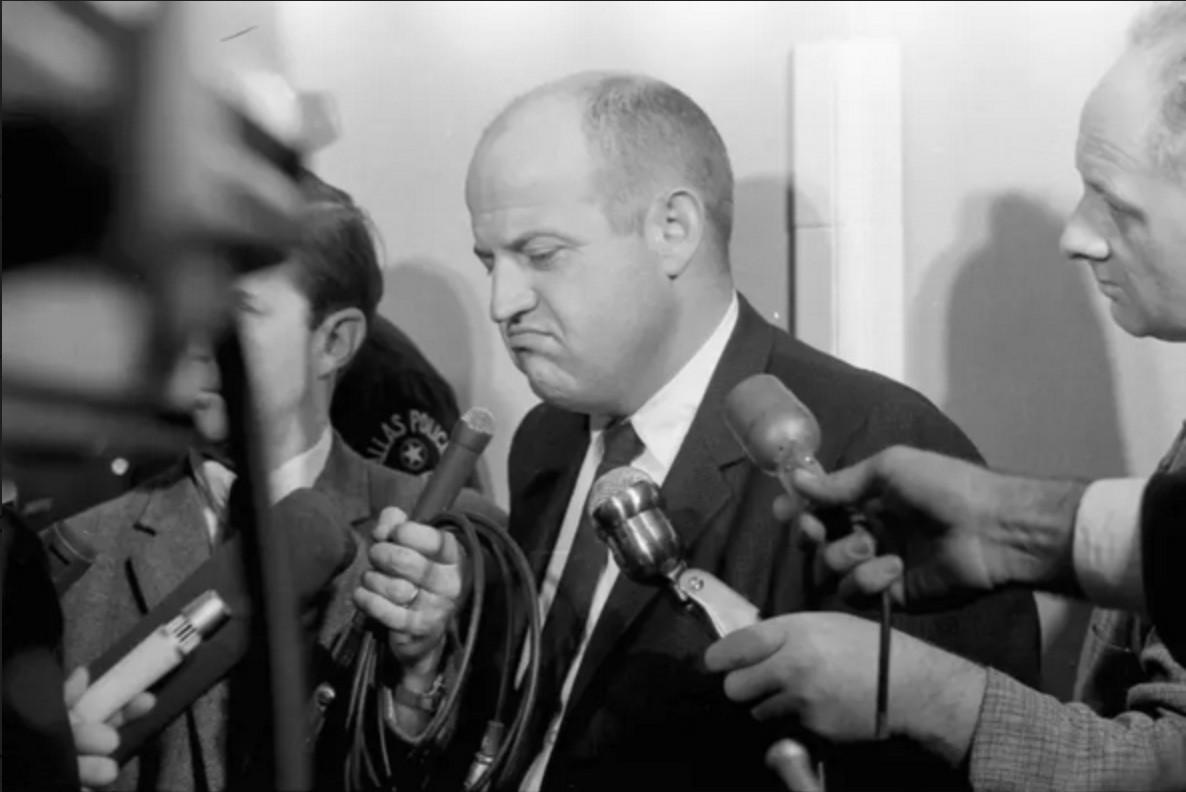
Around 3:00 PM Sgt. Gerry Hill, a former television news reporter, was interviewed by reporters on camera. Hill told newsmen, "The only way we found out what his name was, was to remove his billfold and check it ourselves; he wouldn't even tell us what his name was." During the interview a reporter asked Hill, "What was the name on the billfold?" Hill replied, "Lee H. Oswald, 0-S-W-A-L-D." No mention at all of the name Hidell. During the ride to police headquarters there was no mention of any identification for Alek James Hidell. Hill then began talking with the reporters about Oswald's "defection," his life in the Soviet Union, his Russian wife. When a reporter asked Hill how he knew about Oswald's activities in the Soviet Union, Hill said "Westbrook told me!" It was obvious that on November 22, Captain Westbrook knew far too much about HARVEY Oswald.
A few minutes after 4:00 PM Secret Service agent Forrest Sorrels talked to Oswald in Fritz's office. Oswald said, "What am I going to be charged with? Why am I being held here? Isn't someone supposed to tell me what my rights are? It is obvious to agent Sorrels that Oswald had no idea of what he was being accused of.
Harold E. McDervid, a lawyer from Chicago, tried to contact Oswald via telephone thru the Dallas police to offer his legal services, but was unsuccessful. He then sent a telegram to Oswald, but never received a reply.
At the end of Oswald's 1st interrogation SA James Hosty was approached by an FBI Counterintelligence agent who ordered him to have no further discussions with Oswald and conduct no investigations into Oswald's background.
By 6:20 PM, only 4 hours after Oswald was arrested, his demeanor had shifted from that of a confident, self-assured, somewhat arrogant individual to that of a man who was concerned enough about his predicament to be insisting on a lawyer and denying that he killed anyone. At 6:30 P.M., on his way to a lineup, Oswald shouted to reporters, "I didn't shoot anyone, "I want to get in touch with a lawyer, Mr. Abt, in New York City, I never killed anybody."
At 6:37 PM while walking thru the hall back to Fritz's office, Oswald responded to reporter's questions and said "I don't know where you people get your information. I haven't committed any acts of violence..... I want to get in touch with a lawyer, Mr. Abt, in New York City.... I never killed anybody."
According to SS Agent Forrest Sorrels it was vey difficult for anyone to get to the 3rd floor of the police station. Sorrels told the Commission, "..... almost every time I went up there, definitely after the 22nd, I would have to identify myself to get in past the entrance of the elevator on the third floor....Many times I would be going to the third floor area there, they would start to stop me.... I would have to go ahead and identify myself.''
WFAA-TV employee Vic Robertson saw Jack Ruby try to enter Captain Fritz's office when Oswald was being questioned, but was stopped by two uniformed officers who were stationed outside. It would appear that a Dallas police officer or police official allowed Ruby access to the 3rd floor.
At 7:10 PM Justice of the Peace David Johnston came to Fritz's office. Oswald was told that he was being charged with the murder of Officer J.D. Tippit. Assistant District Attorney Bill Alexander said that Oswald, "disclaimed any knowledge of anything." When Oswald was removed from Fritz's office reporters heard Oswald say that he was given a hearing without any legal representation, and denied that he shot anyone.... "I insist upon my constitutional rights. The way you are treating me, I might as well be in Russia."
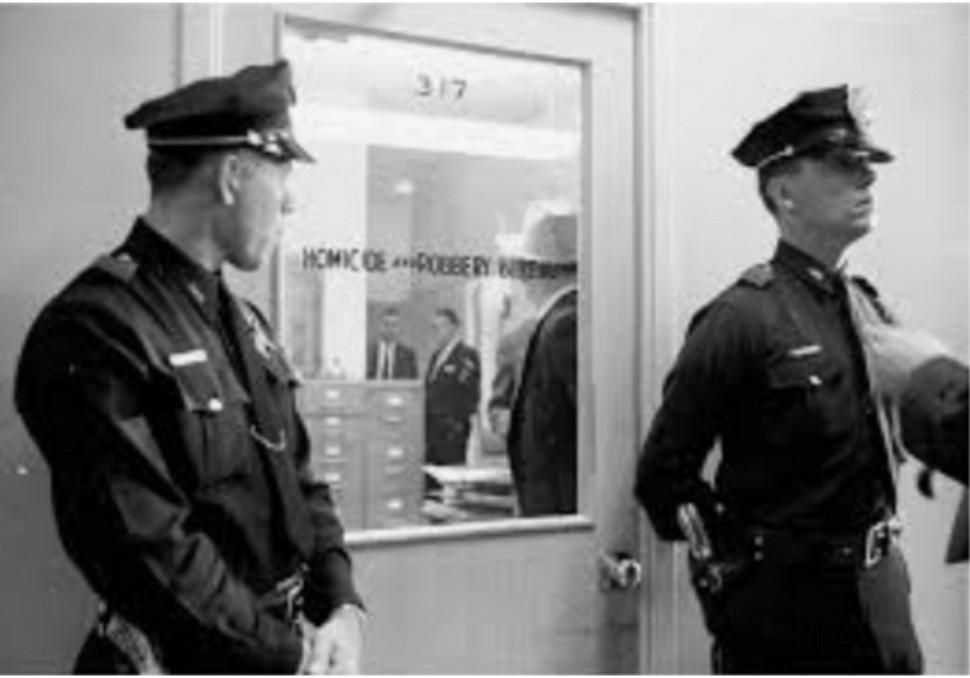
Between 2:30 PM and 7:30 PM HARVEY Oswald was taken to police line-ups several times, while his arrest wallet remained on the table in Fritz's small office. This photo, taken on November 22, shows the entrance to the Homicide and Robbery Department with Fritz's small office inside and on the right. In the hallway are two uniformed policemen who were instructed not to let anyone in the Homicide office without permission. Only police Captains and assistant Police Chiefs had unlimited access to Fritz's office.
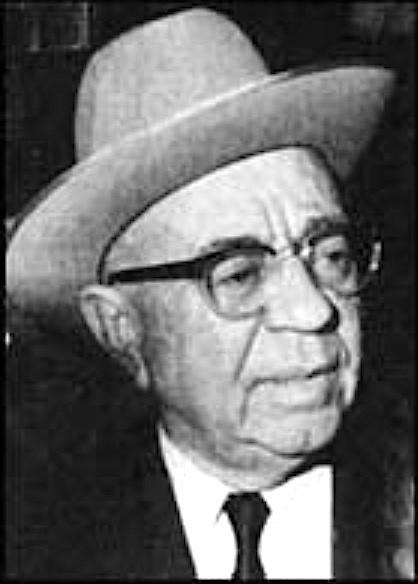
I believe that Will Fritz, as Captain of Homicide & Robbery since 1932, clearly understood the purpose of the 2nd Oswald wallet, shown to fellow police officers by Capt. Westbrook at the Tippit murder scene. The purpose of this wallet was to frame HARVEY Oswald for Tippit's murder. But a 2nd wallet could also have alerted the public and the press to the possibility of two Lee Harvey Oswalds. The 2nd wallet could never be entered into evidence, never photographed, and never mentioned by any Dallas police officer to anyone. The 2nd wallet from 10th & Patton had to disappear, and could never be discussed or shown to the Warren Commission, the public, or to the press. Somehow, information and knowledge of the 2nd wallet, known to many Dallas police officers and officials, had to be kept secret.
District Attorney Henry Wade
HARVEY Oswald was arrested for murdering Officer Tippit, and yet Capt. Fritz interrogated Oswald on Friday, Saturday, and Sunday morning, but asked Oswald only a few questions about his involvement with the Tippit murder. For years I never understood why Fritz failed to interrogate Oswald about the Tippit murder, and why Fritz never explained his reason for intentionally failing to question Oswald about the Tippit murder. Like Henry Wade said, "Fritz was reluctant to tell others what he was doing."
Now, after realizing the purpose of the 2nd wallet was to frame an innocent man for murder, I finally understood why Fritz never questioned Oswald about the Tippit murder.... I believe that Fritz knew the 2nd Oswald wallet was to frame HARVEY Oswald for the Tippit murder, and Fritz probably believed that Oswald was innocent. The 2nd wallet was never photographed by the Dallas police, never entered into evidence, and most certainly never shown to HARVEY Oswald. Fritz dared not question Oswald about the Tippit murder, because he knew that Oswald would deny any involvement in front of numerous state and federal witnesses in the interrogation room. Worse yet would be if Oswald began to talk about his connections with the FBI and CIA and his government sponsored "defection" to the Soviet Union, because Oswald began to realize that he was being framed and knew that he was the "patsy." Fritz knew better than to ask Oswald any questions about the Tippit murder and, as we shall see, he thwarted Oswald's efforts to contact a lawyer, perhaps fearing what secret information Oswald might share with his lawyer.
Capt. Fritz, however, had to resolve the problem of a 2nd wallet, and had to make sure that neither the public nor the press ever learned about the 2nd wallet. This meant that, somehow, Dallas Police officers and in particular officers from 10th & Patton, remained completely silent about the 2nd wallet. We don't know what caused senior police officials and dozens of police officers from 10th & Patton to never discuss the 2nd wallet but we know it happened--because not a single Dallas Police officer ever said a word to the press, the public, or the Warren Commission about the 2nd wallet !!
Capt. Westbrook, Capt. Fritz, Capt. Doughty, Sgt. Owens, Sgt. Croy, and other police officers from 10th & Patton were interviewed by the Warren Commission, but nobody said a word about the 2nd Oswald wallet. FBI agents Barrett and Hosty also said nothing about the 2nd wallet. I find it hard to believe the 2nd wallet, with identification for Alek James Hidell, was not discussed among police officers, detectives, and senior police officers in the days following Oswald's arrest. But neither FBI agent Barrett, Capt. Westbrook, Capt. Fritz, Capt. Doughty, Sgt. Owens, Sgt. Croy, or any Dallas police officer wrote a report or said a word about the 2nd wallet to the Warren Commission or to anyone. Capt. Doughty and Sgt. Bud Owens were filmed by news reporter Ron Reiland while examining the wallet, but they said nothing to the Warren Commission. Therefore, it appears that certain officials in the Dallas Police Department made a concerted and determined effort to conceal any and all information about the 2nd wallet which was clearly a huge coverup within the Dallas Police Department and the 2nd most important puzzle of the Tippit murder. More research is needed, but I'll bet that Capt. Westbrook was in charge of ordering police officers to say nothing about the 2nd wallet.
Capt. Fritz, refusing to question Oswald about the Tippit murder, covering up the existence of a 2nd Oswald wallet, and not entering the 2nd wallet into evidence or discussing it with the Warren Commission, the press, or the public, are valid reasons to question Fritz's honesty and integrity. We must now wonder how much trust to place in Fritz, his Warren Commission testimony, and his handwritten notes which first appeared in 1997 when given anonymously to the ARRB.
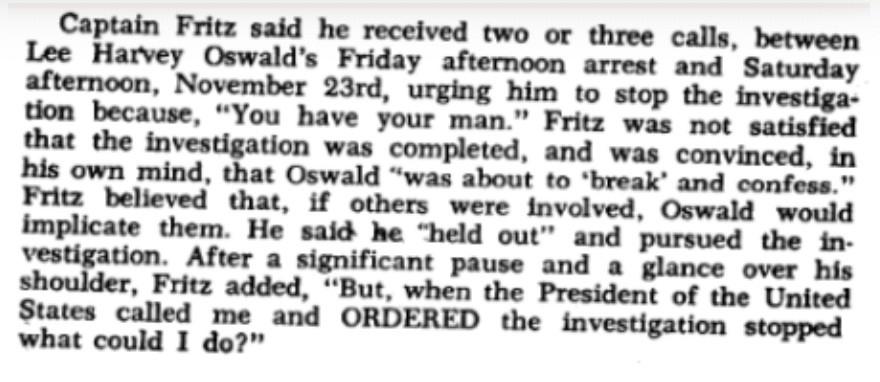
News article about Fritz (Forgive My Grief,
Penn Jones, pg. 101)
Thirteen years later, in 1975, Fritz briefly discussed his interrogation of Oswald, as described in the news article. Fritz said that from the time Oswald was arrested thru Saturday afternoon he received two or three phone calls urging him to stop the investigation because "you have your man." Fritz then said on Saturday afternoon he was told there was a call holding for him from the White House. On the line, according to Fritz, was President Lyndon Johnson who supposedly told Fritz, "You've got your man, now we'll take it from here." Fritz said, "When the President of the United States called and ordered the investigation stopped, what could I do?" A call to Fritz from President Johnson on November 23 may or may not have happened, but there is no hard evidence to confirm such a phone call. Fritz talked about this phone call for the first time in 1975, twelve years after President Kennedy was murdered, and two years after Lyndon Johnson died. This phone call was the only explanation ever given by Fritz to explain why he never questioned Oswald about the Tippit murder. I speculate the phone call from President Johnson never happened, because it is much more likely that if President Johnson wanted the Dallas Police to stop the investigation, he would have called either Mayor Cabell or Dallas Police Chief Curry directly.
When Oswald arrived at police headquarters he should have been searched. His arrest wallet and contents should have been sent immediately to the identification bureau. A written report should have been made listing the items found in his wallet and photographs made of each item. However, this was not done.
Alek James Hidell ID cards are placed in Harvey Oswald's arrest wallet
At some point between Oswald's first interrogation at 2:30 PM and being charged with murder at 7:10 PM one or more identification cards with the name Alek James Hidell from the 2nd wallet were placed in Oswald's arrest wallet, which was in Capt. Fritz's office. The 2nd wallet from 10th & Patton then disappeared and was never seen again. Now, the most important item in the 2nd wallet was the Alek James Hidell ID card with Oswald's photo, because this card linked Oswald with the rifle ordered from Klein's Sporting goods by A. Hidell and shipped to Oswalds post office box in Dallas.Between 1:30 and 2:00 PM, before Oswald arrived at police headquarters, an unidentified person from the Dallas police contacted Col. Robert Jones of the 112th Army Intel group in San Antonio. This unidentified person advised that Oswald, when arrested, had Alex James Hidell ID cards in his possession. The unidentified person was Sgt. George Doughty, who was also a member of the 112th Army Intel group and was photographed at 10th & Patton holding and examining the 2nd wallet. Jones contacted the FBI office in San Antonio, who then contacted the FBI office in Dallas. FBI Director Hoover was soon advised of the Hidell identification cards. Arrangements were made to send 3 FBI agents to Klein's Sporting Goods in Chicago. The agents were told to search company records in an attempt to locate an order placed by Alek Hidell for a Mannlicher Carcano rifle, serial number C2766.
The 3 agents arrived at Kleins office at 10:00 PM and were met by Klein's Vice-President William Waldman. The agents began looking thru the companies microfilm records. Hours later the agents asked and received permission from Waldman to take the Klein's microfilm for further examination. The microfilm soon arrived at FBI headquarters in Washington, DC. Television stations, radio stations, and newspapers soon reported to the nation that a $12.78 mail order rifle was used to assassinate President Kennedy, which was not true. During the next week the FBI focused their attention on the 40" Mannlicher Carcano rifle found in the Book Depository, and on the Klein's microfilm. On November 29, for the first time, the Atlanta Journal correctly reported, from a UPI dispatch, that Oswald purchased an Italian rifle with scope from Klein's Sporting Goods in Chicago in March, 1963 for $21.45 including postage. Why did it take nearly one week for the FBI to "find" this order on microfilm....or was it during this week that the FBI fabricated a Klein's order form with the name A. Hidell and Oswalds post office box in Dallas.
The FBI produced photographs of a Klein's order form that showed A. Hidell ordered a rifle shorter than the one found by the Dallas Police. The rifle on the order form was not the same the rifle found in the Book Depository. In fact, Milton Klein said that his company did not sell or ship any rifle to A. Hidell in Dallas. But Klein was unable to prove this, because his companies original microfilm was confiscated by the FBI and soon disappeared. Today, no original microfilm records exist, only FBI photographs. Klein told the National Guardian, "I've had more than enough publicity....and the FBI has told me to keep my trap shut."
The FBI provided the Warren Commission with photographs of a Klein's order form with the name A. Hidell, PO Box 2915, Dallas, Texas. They provided photographs of a US postal money order that was allegedly used to pay for the rifle in the amount of $21.45. The original roll of Klein's microfilm and the US postal money order were allegedly sent to the National Archives. When I visited the National Archives and asked to look at the Klein's microfilm I was given a photograph of the box in which the microfilm was held, but the box was empty. I was given photographs of the postal money order, no original.
The Alek James Hidell ID card linked (Harvey) Oswald to the rifle found on the 6th floor of the Book Depository. But did Oswald really order and receive this rifle at his post office box in Dallas? No, and proving this fact is very simple.
Oswald allegedly purchased a postal money order at the Dallas post office to pay for the rifle in Dallas at 10:30 AM on Monday, March 12. He then, allegedly, put the money order and a Klein's order coupon in an envelope which he placed in a mail box several miles from the post office. The mail order for the rifle was allegedly received by Klein's in Chicago the following day. The rifle was then allegedly mailed to Dallas, and received in Oswald's post office box.
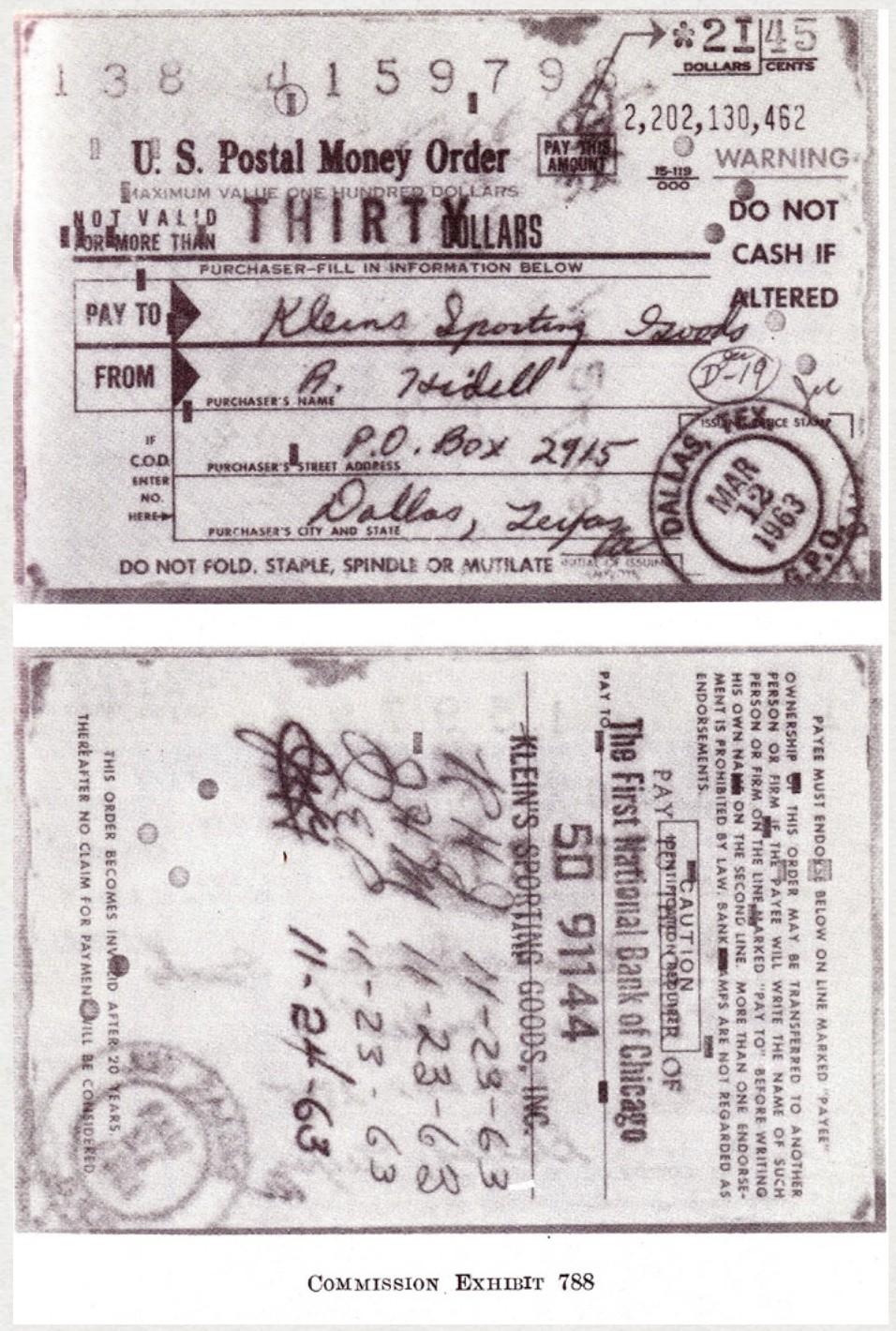
This is an FBI photograph of the money order allegedly sent to Klein's to pay for the rifle. The back side of this money order shows a rubber stamp endorsement to the First National Bank of Chicago. But this money order was never date stamped by a bank, nor date stamped by a Federal Reserve Bank nor deposited to the First National Bank of Chicago or to any bank. The original money order, a copy of which is published in the Warren Volumes, disappeared and only photographs remain. The sequential numbering of postal money orders allows us to determine the approximate date this money order was available for purchase. The number of this money order, 2,202,130,462 was not available for purchase at the Dallas post office until late 1964 or early 1965. This money order could not have been used to purchase a rifle in March, 1963, but was likely pulled from a stack of fresh, unsold money orders by a postal official in Dallas sometime after the assassination and then given to the FBI. A close look at the details surrounding the "finding" of the money order the day after the assassination strongly suggests that this is what happened.

The checks above, issued to Oswald, were from the State Comptroller and from Wm. B. Reily Company in New Orleans. These checks, and all checks and money orders deposited to a bank, are always date stamped by the bank into which the check was deposited or cashed. The US postal money order was allegedly purchased by Oswald on March 12, 1963 but was never date stamped by a bank, or a Federal reserve bank, which means this US postal money order was never cashed or deposited to a bank.
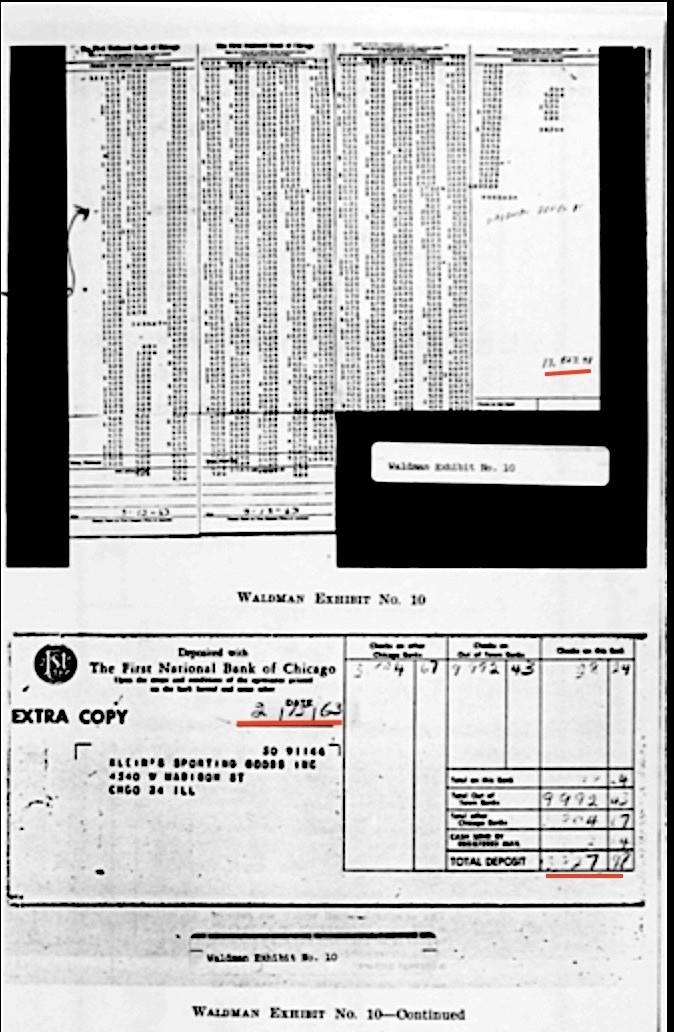
The postal money order was allegedly deposited to Klein's account at the First National Bank of Chicago. The Warren Commission published Klein's bank records, which show the date of deposit for the $21.45 postal money order. The U.S. postal money order is dated March 12, 1963, but Klein's deposit slip at the First National bank is dated February 15, 1963. A money order purchased on March 12, cannot be deposited to Klein's bank account a month earlier, on February 15.
The FBI gave the Warren Commission photographs of Klein's business records, photographs of bank records, a photograph of an uncashed/never deposited money order, and a photograph of a deposit slip dated one month before the rifle was allegedly ordered from Klein's. The Warren Commission used these FBI photographs to conclude that Oswald purchased the rifle found on the 6th floor of the TSBD.
The fake Alek James Hidell ID card and the planting of the rifle on the 6th floor of the Book Depository helped create the illusion that Oswald murdered President Kennedy. But there was more, much more manipulation, fabrication, and alteration of evidence done by the Dallas Police and the FBI to help convince the public that Oswald shot and killed President Kennedy and Officer J.D. Tippit.
225 items of evidence sent to the FBI
On November 22 President Johnson told his aide, Cliff Carter, to contact Dallas District Attorney Henry Wade and order him "not to allege a conspiracy," and then to order Dallas Police Chief Jesse Curry to immediately turn over all of the evidence collected by the Dallas Police to the FBI. Curry told the Warren Commission, "We got several calls insisting we send this, and nobody would tell me exactly who it was that was insisting, 'just say I got a call from Washington, and they wanted this evidence up there,' insinuated it was someone in high authority that was requesting this...."Curry said, "about midnight Friday night---November 22---we agreed to let the FBI have all the evidence and they said they would have an agent stand by (FBI agent Vince Drain) and when they were finished with it, they would return it to us."The Dallas Police then gave the FBI agent 225 items of physical evidence, without a written inventory, which departed from Carswell Air Force Base aboard a C-130 tanker at 3: 10 am for Washington, DC.
On November 23, several days before the FBI "officially"became involved in the investigation, all of Oswald's possessions were at FBI headquarters in Washington, DC. A few hours later, around 9:00 AM on Saturday morning, FBI document specialist James Cadigan received Oswald's possessions, a total of 225 items. The Dallas Police had identified the evidence from Ruth Paine's house as Stovall A and Stovall B.
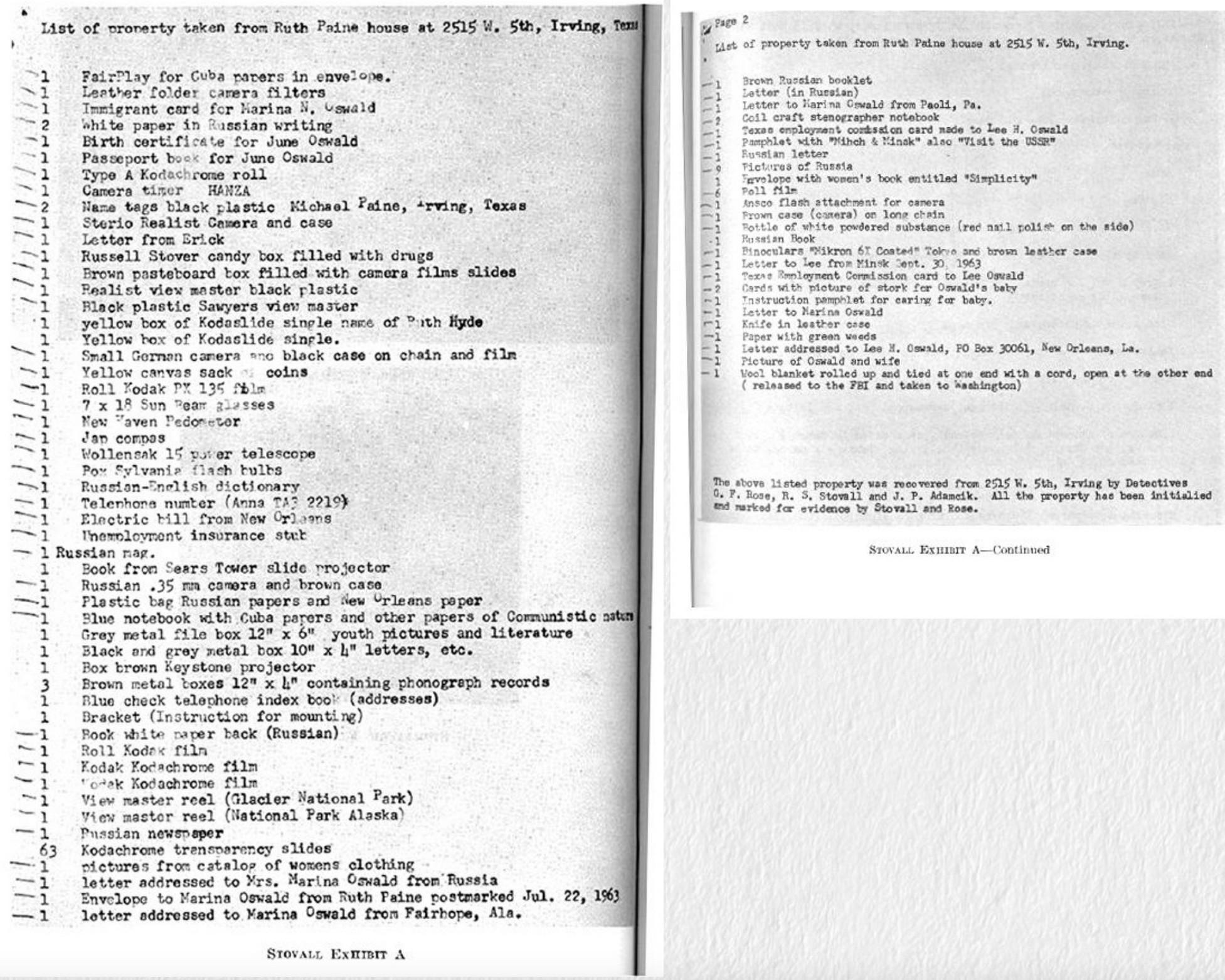
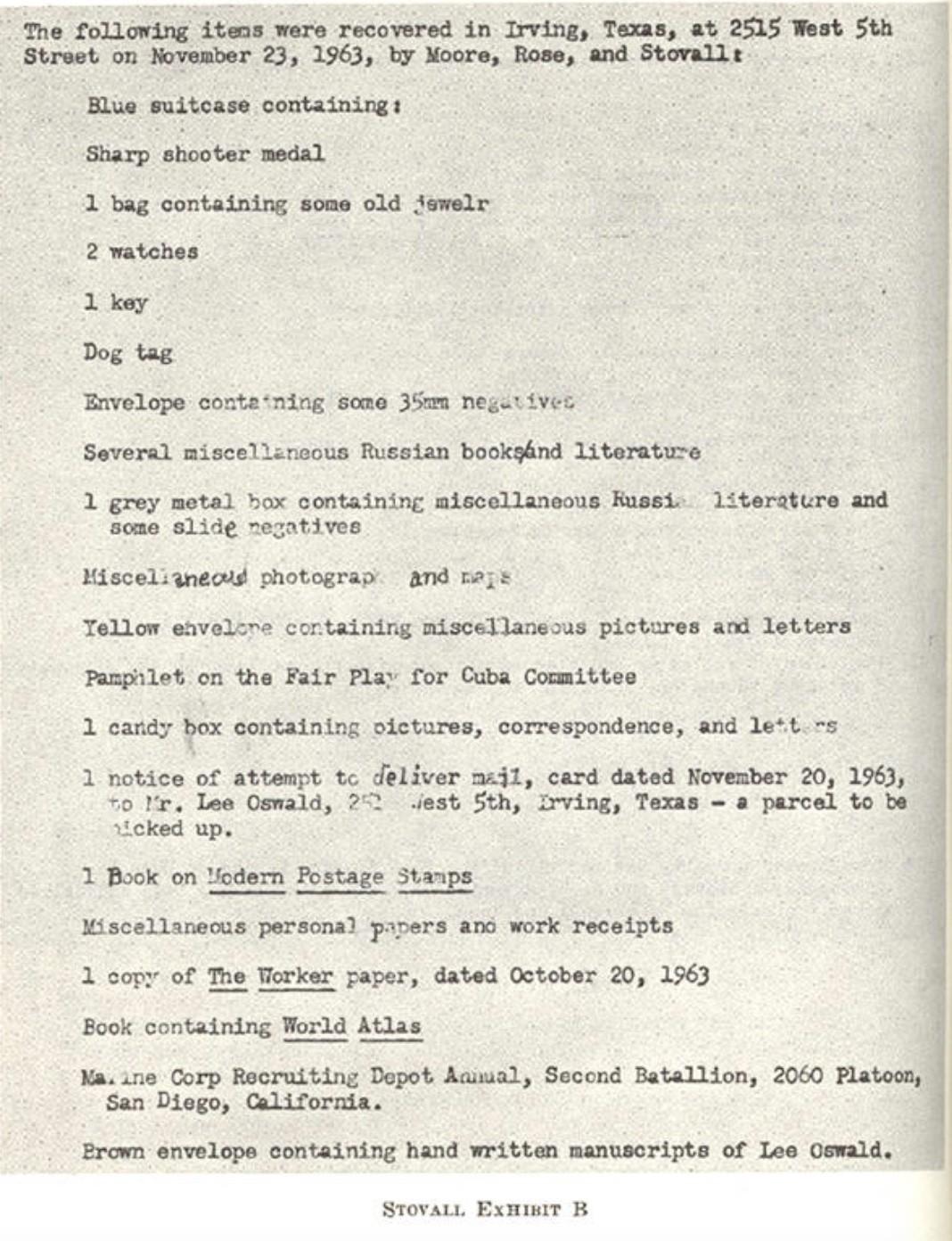
The evidence from Oswald's rooming house on Beckley was Turner Exhibit 1.
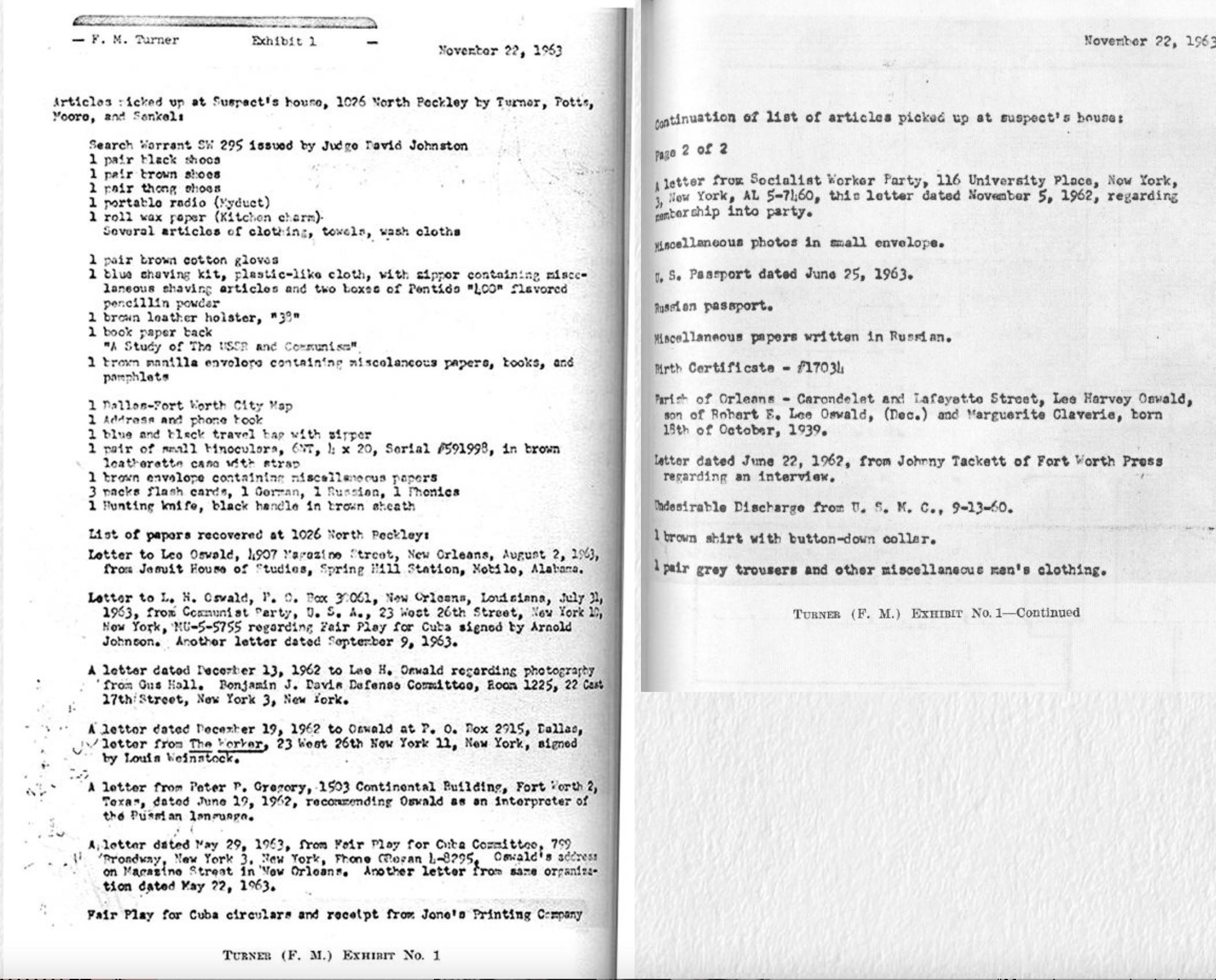
The same day, November 23, FBI Associate Director Clyde Tolson sent a memo to FBI official Alan Belmont. Tolson wrote, "results of the investigation have been reduced to written form and consequently the information will all be available for these two supervisors. We will set forth the items of evidence which make it clear that Oswald is the man who killed the President."
Only one day after the assassination the FBI had already decided, in written form, that Oswald killed Kennedy, and all they needed to do was make sure the items of evidence, which were now at FBI headquarters in Washington, DC, supported their report.
On November 23, the Dallas Police sent the FBI 225 items of evidence collected by the Dallas Police from Oswald's rooming house and Ruth Paine's home in Irving, TX. Three days later, on November 26, the FBI returned 455 pieces of evidence to the Dallas Police, which was 230 more items than they received from the Dallas Police. The FBI and Dallas Police then jointly photographed, numbered, and inventoried all 455 items. Each item was listed and numbered individually, line by line, and listed on Warren Commission Exhibit CE 2003. CE 2003 shows 455 items of evidence--the original 225 items of evidence the Dallas Police sent to the FBI on November 23, and 230 items of evidence that were added by the FBI. After the joint FBI/DPD inventory and photographing was complete (11/26/63) the FBI took the evidence, and the 5 rolls of undeveloped film, to Washington, DC.
FBI official William Sullivan knew the FBI's capabilities and said, "When an enormous organization like the FBI with tremendous power still can sit back and shuffle the deck of cards and pick up the card they want to show you it may be you're not going to get the entire picture as fully as you would otherwise.... If there were documents that possibly he (Hoover) didn't want to come to the light of the public, then those documents no longer exist, and the truth will never be known." Exactly, the truth will never be known.
The additional 230 items of "evidence" that were added to Oswald's possessions by the FBI are easy to identify, if you know what to look for. Each of the original 225 items of evidence were initialed and dated by Dallas Police officers. These original items were then listed on handwritten inventories, later on DPD type-written inventories, and photographed. But the 230 items of evidence added by the FBI were not initialed or dated by Dallas Police officers, they do not appear on either the handwritten or type-written DPD inventories, and were not photographed on the floor at DPD headquarters. Why would the FBI add 230 items of evidence? The 230 items added by the FBI either belonged to LEE Oswald, were added to help merge the historical background of HARVEY Oswald and LEE Oswald into one fictional "Lee Harvey Oswald,"or were added to help frame HARVEY Oswald as the "patsy."
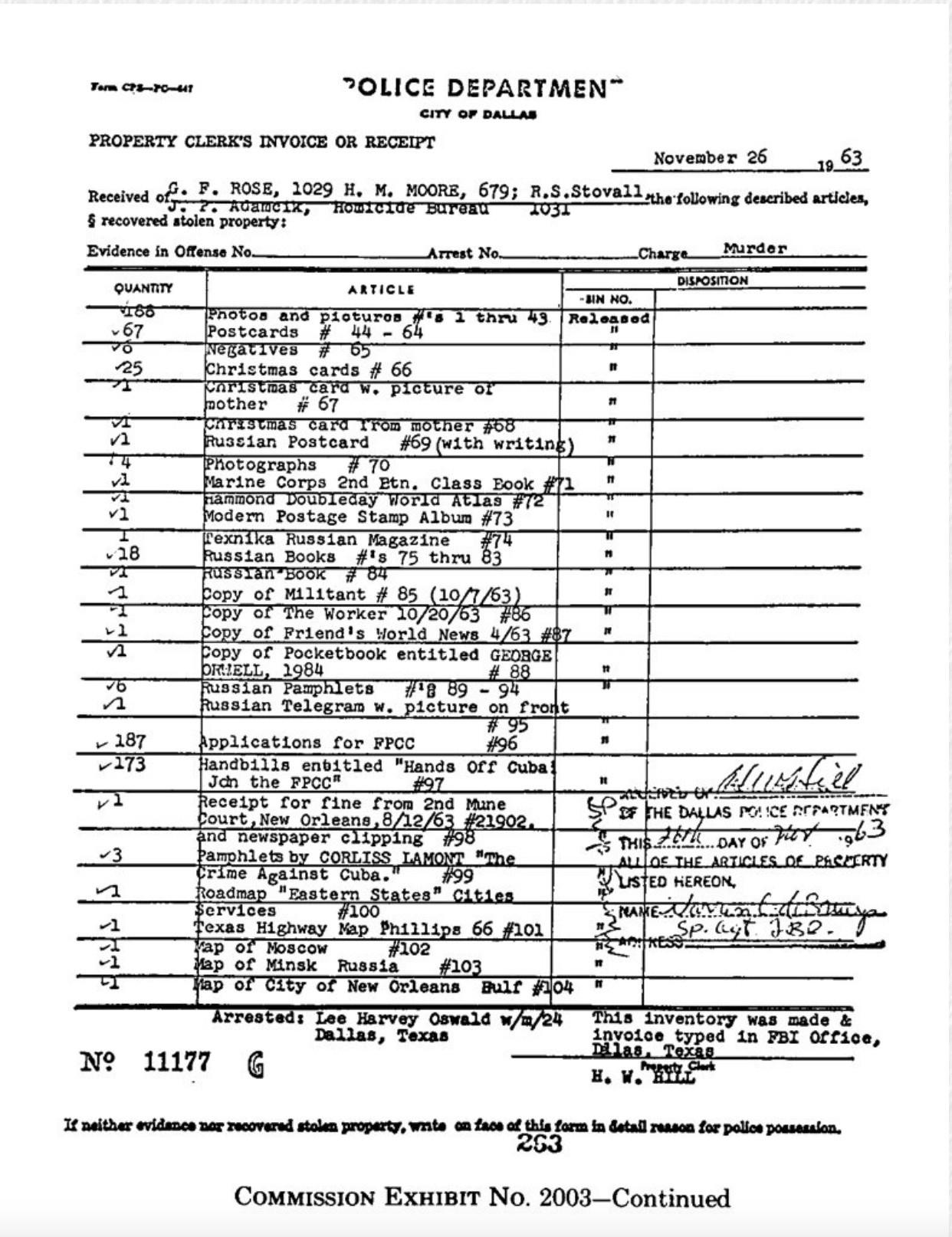
In 1997 I spent several weeks at the National Archives. Every day I looked at items of evidence listed on the joint Dallas Police/FBI inventory, shown as CE2003 in the Warren Volumes. I placed the Dallas Police inventory list of 225 items side by side with the 455 items listed on CE 2003, which is the joint FBI/Dallas police inventory that was created on November 26, 1963. I eventually managed to look at nearly all of the 455 items of evidence, and checked each item for the initials and dates of the Dallas Police. If an item was initialed and dated by Dallas police, then this item was original evidence. It an item was not initialed and initialed, then that item was added by the FBI to the original 225 items of evidence. Some of the items added by the FBI were clear fabrications, such as the 1955 and 1956 w-2 forms allegedly given to Lee Harvey Oswald. Other items, such as New York City school records, were altered and merged. Other items, such as photographs taken in Europe, were added. More information about this manipulation of evidence is available on the this website, in an article titled Manipulated, Fabricated, and Disappearing Evidence.
Oswald's arrest wallet
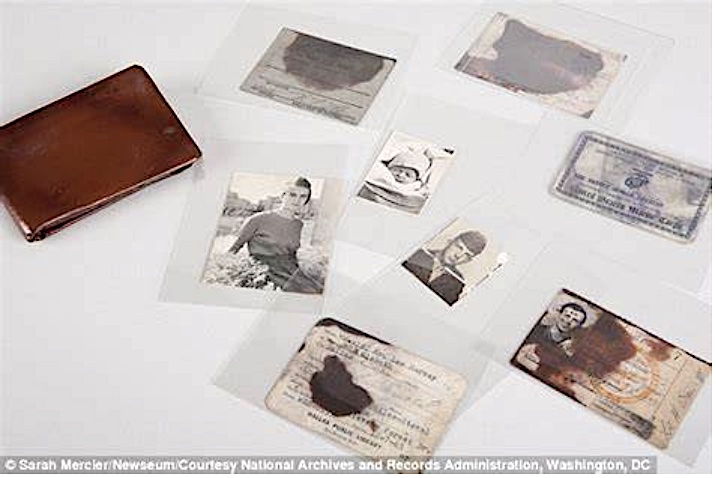
The above photograph, from the National Archives, shows the contents of Oswald's brown wallet and the wallet itself (the arrest wallet), a total of 9 items. Unfortunately, the contents of Oswald's arrest wallet were not recorded when he arrived in the police station at 2:00 pm.
The AleX James Hidell ID card
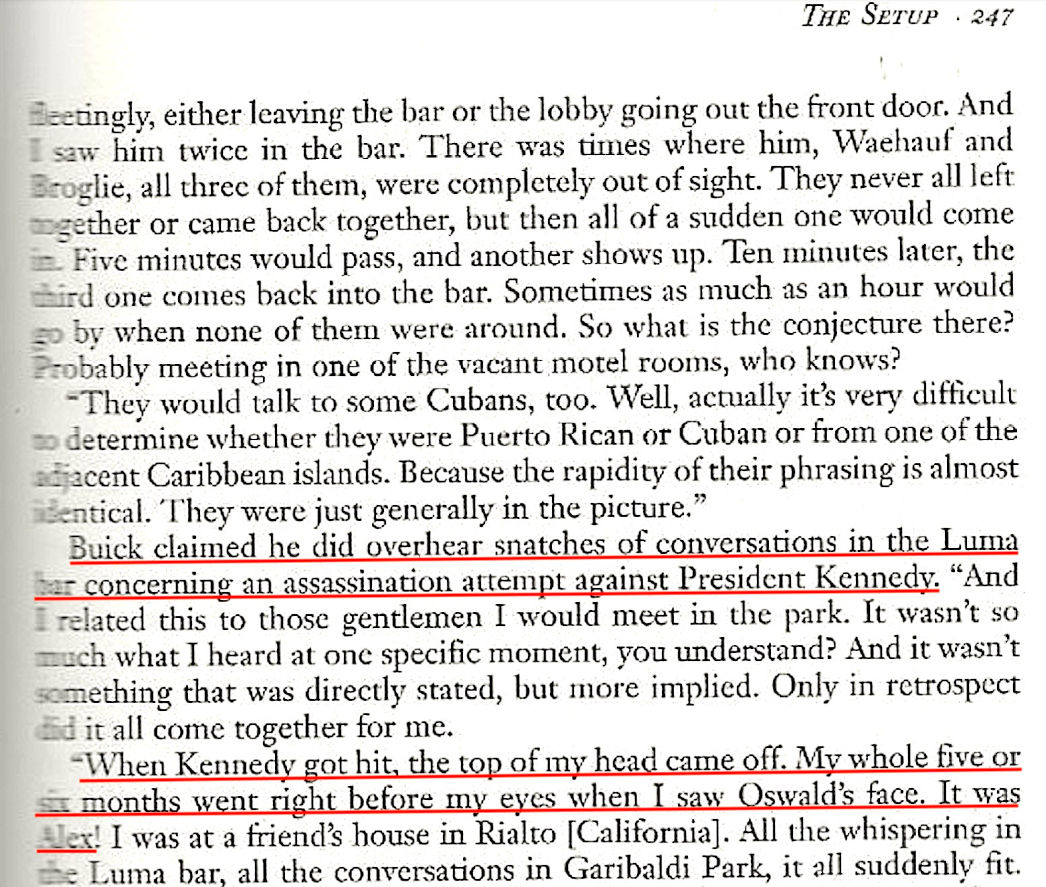
Buick told author Dick Russell that he heard
"snatches" of conversations in the Luma Bar concerning an assassination
attempt on President Kennedy. After President Kennedy was shot, and
Oswald's photo appeared on television, Buick instantly recognized him
as Alex James Hidell, the man he met and spoke with at the Hotel Luma
in Mexico City. It was LEE Oswald who met with Robert Buick in Mexico
City using the alias "AleX James Hidell." This may be the beginning of
LEE Oswald setting up HARVEY Oswald for the assassination of President
Kennedy. In the summer of 1963 Harvey Oswald and Marina were in New
Orleans, where Harvey Oswald was using the name "A. Hidell" in
connection with his FPCC activities. LEE Oswald, using his assigned
alias of "AleX Hidell," was involved in conversations wherein the
assassination of President Kennedy was discussed. On November 22, 1963
the name "Alek James Hidell" would connect HARVEY Oswald with
discussions in the Hotel Luma about the assassination of President
Kennedy. The name "Alex James Hidell" would also connect Harvey Oswald
with the rifle found on the 6th floor of the Book Depository, allegedly
ordered from Klein's Sporting Goods in Chicago. LEE Oswald using the
alias "AleX Hidell" and HARVEY Oswald using the alias "A. Hidell"
and/or "AleK Hidell" on his FPCC literature in the summer of 1963 was
not a coincidence.
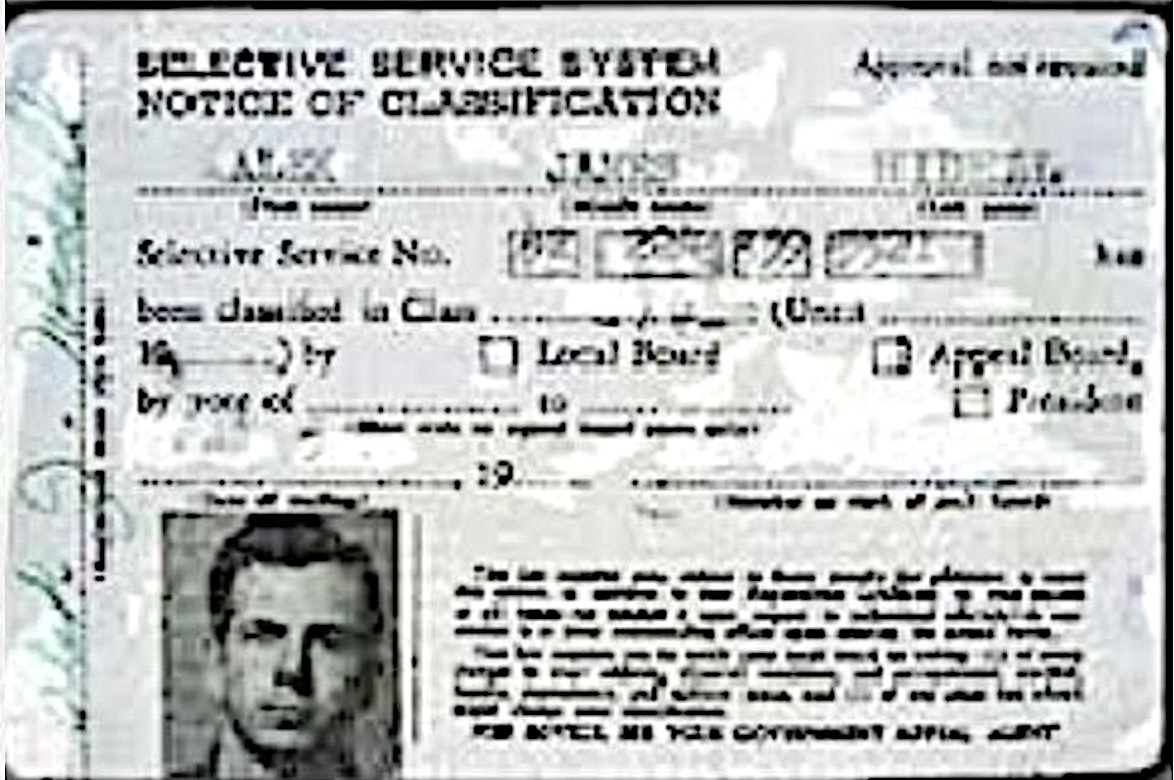
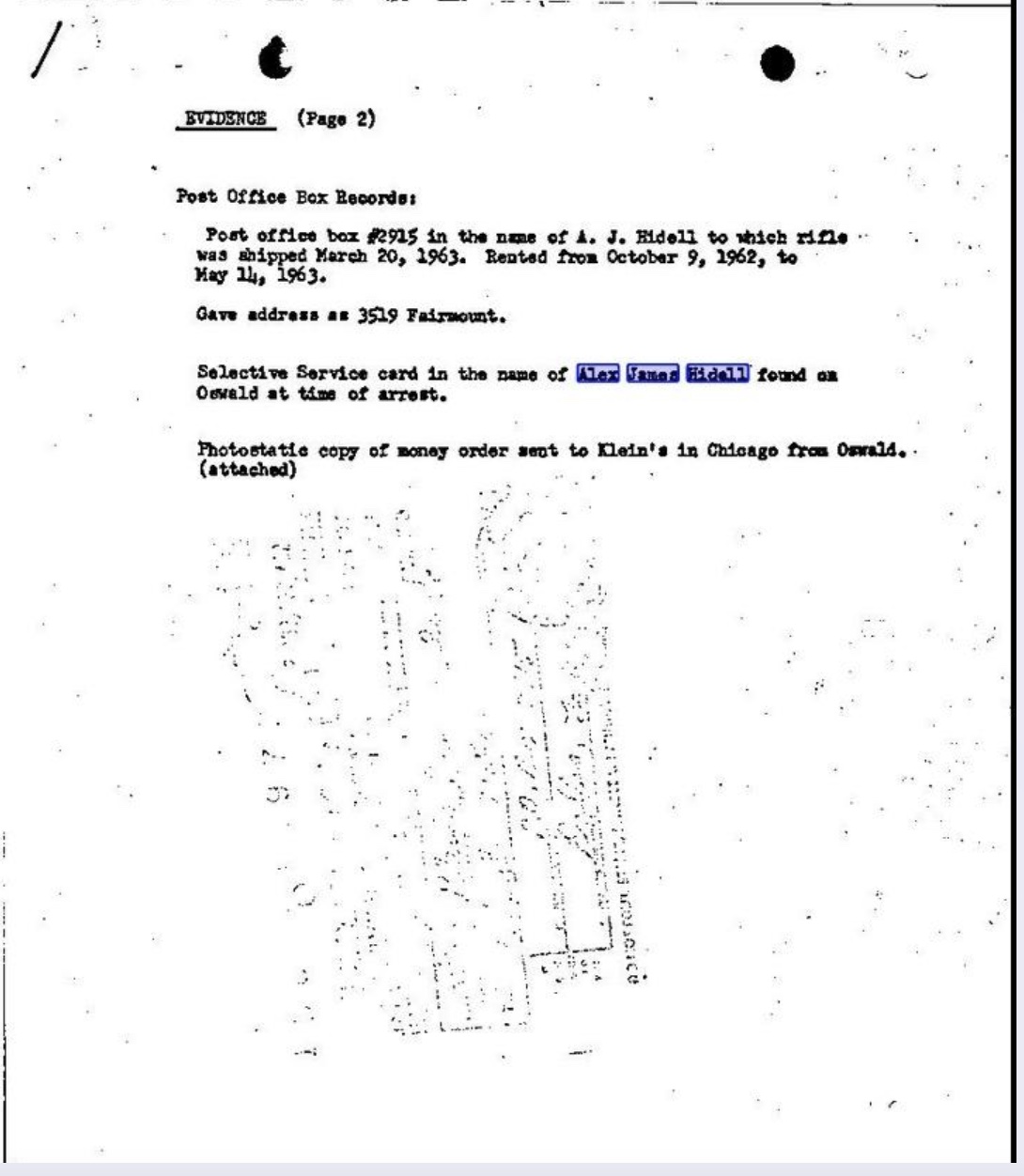


Two fictitious Selective Service ID cards, with the
names AleX James Hidell (shown above) and AleK James Hidell, were among
the items in the 2nd Oswald wallet at 10th & Patton on November 22,
1963, when shown to fellow police officers by DPD Capt. Westbrook. Both
of these ID card were removed from the 2nd wallet and placed in
Oswald's arrest wallet by someone in the Dallas Police Dept. Both of
these ID cards were identified and described by the Dallas Police.
AleK James Hidell
The earliest known use of the name "AleK James Hidell" was the date of February 5, 1962 on the back side of the "ficticious" Selective Service System Notice of Classification card signed by Alek James Hidell. This card was found, described, and listed on an FBI report.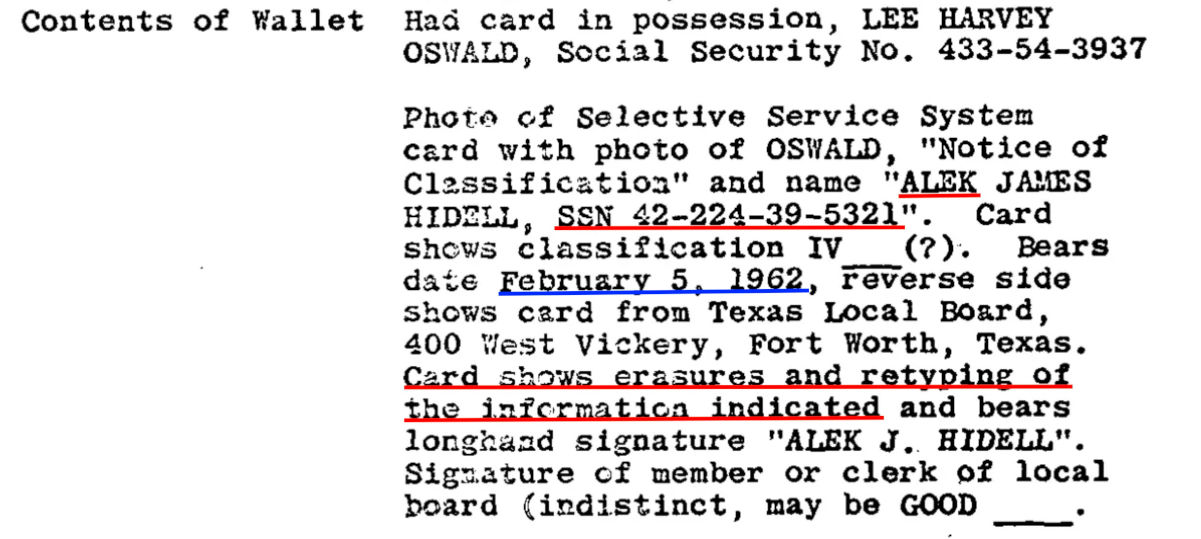
On February 5, 1962 (HARVEY) Oswald was in the Soviet Union. His nickname while in the Soviet Union was "Alik." Accordingly, the CIA classification for HARVEY Lee Oswald was probably "Alek."
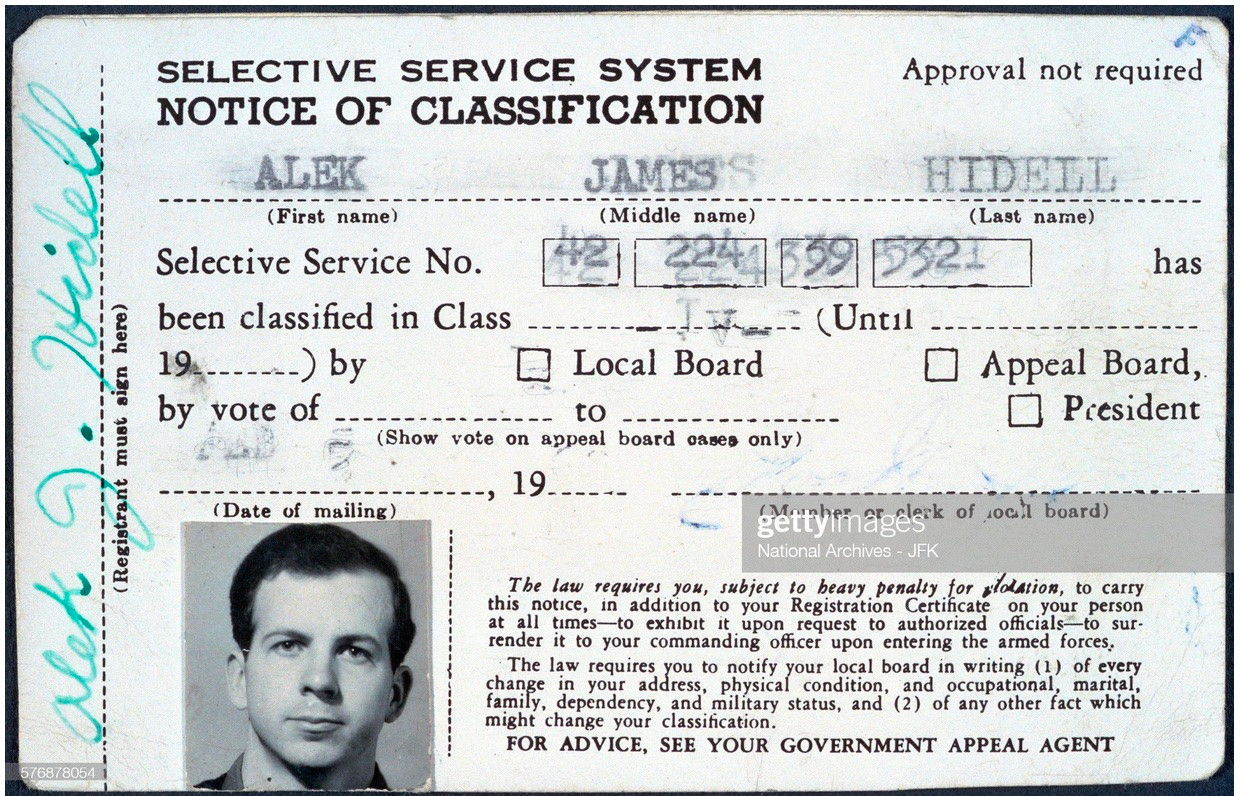
The next time we hear the name AleK James Hidell was around 1:42 PM on November 22, when DPD Capt. Westbrook showed the 2nd Oswald wallet to fellow police officers at the Tippit murder scene and called out the name "Alek James Hidell."
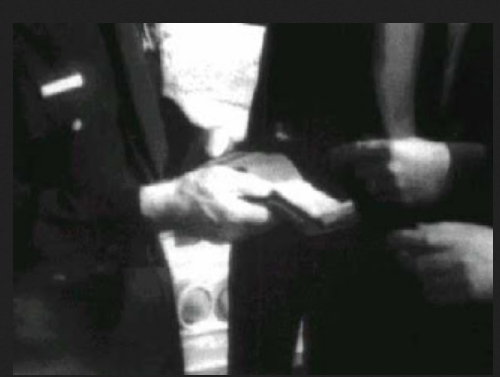
News reporter Ron Reiland photographed Capt. Doherty and Sgt. Owens as they examined the 2nd wallet. Westbrook then asked FBI agent Bob Barrett if he was familiar with the names "Alek/Alex James Hidell" or "Lee Harvey Oswald."
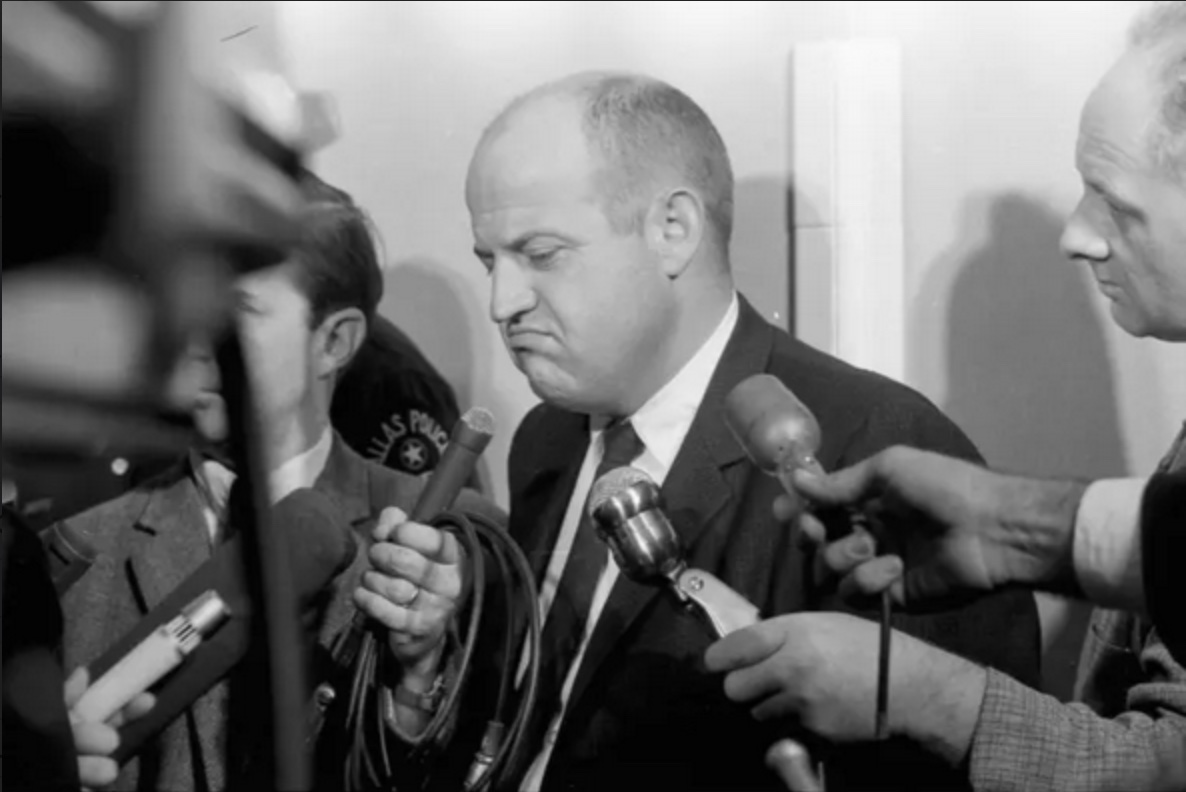
After was arrested, he was placed in Capt.
Westbrook's unmarked police car and driven to police headquarters.
Oswald's wallet (arrest wallet) was removed from his pants pocket and
inspected by Det. Paul Bentley. The name Alex or Alek James Hidell was
not mentioned during the ride to police headquarters, because neither
of the Alek/Alex James Hidell ID cards were in his arrest wallet. Sgt.
Gerry Hill was interviewed by the press shortly after Oswald arrived at
police headquarters. When asked the suspect's name Hill replied
Oswald.... O-S-W-A-L-D.
Capt. Fritz began questioning Oswald around 2:30 PM, with Oswald's brown arrest wallet laying on Fritz's desk. It is worth remembering that the contents of Oswald's arrest wallet were not inventoried when he arrived at police headquarters.
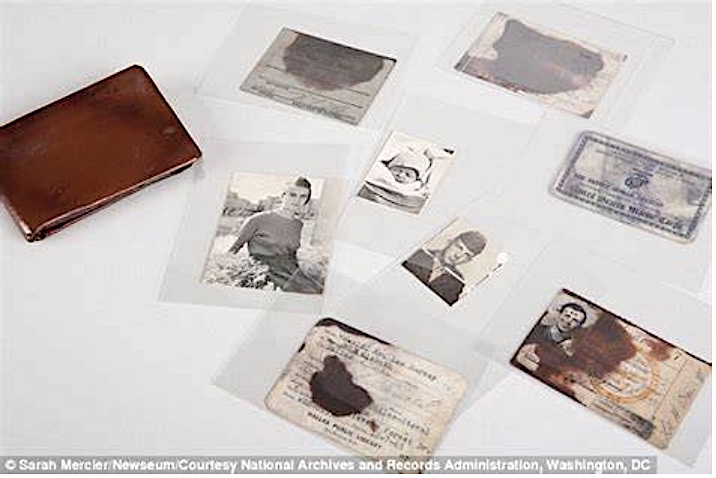
The National Archives made a photograph of Oswald's brown arrest wallet and the 8 original items found in his wallet.
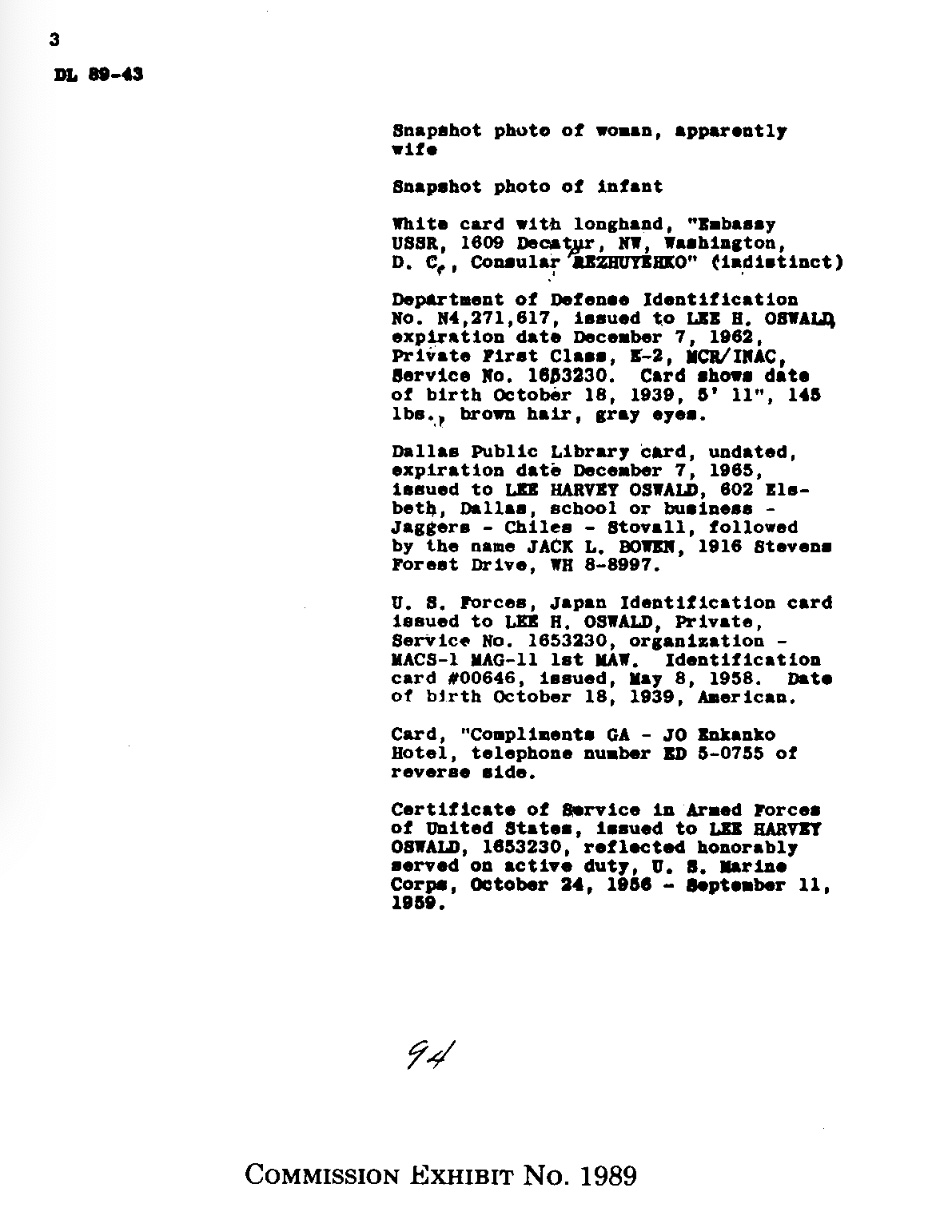
Capt. Fritz began questioning Oswald around 2:30 PM, with Oswald's brown arrest wallet laying on Fritz's desk. It is worth remembering that the contents of Oswald's arrest wallet were not inventoried when he arrived at police headquarters.

The National Archives made a photograph of Oswald's brown arrest wallet and the 8 original items found in his wallet.

The FBI provided the Warren Commission with a list
of
8 items from Oswald's arrest wallet, shown above as CE 1989.


The National Archives and the FBI both
reported that 8 original items were found in Oswald's arrest wallet.
However, when placed side by side the items of evidence are similar,
but are not the same.
That evening, November 22, FBI agent James Bookhout suggested to FBI agent Manning Clements that he interview Oswald. Agent Clements then asked and received permission from Capt. Fritz to interview Oswald (Clements briefly interviewed Oswald at 7:30 PM, 10:00 PM, and 11:30 PM).
That evening, November 22, FBI agent James Bookhout suggested to FBI agent Manning Clements that he interview Oswald. Agent Clements then asked and received permission from Capt. Fritz to interview Oswald (Clements briefly interviewed Oswald at 7:30 PM, 10:00 PM, and 11:30 PM).
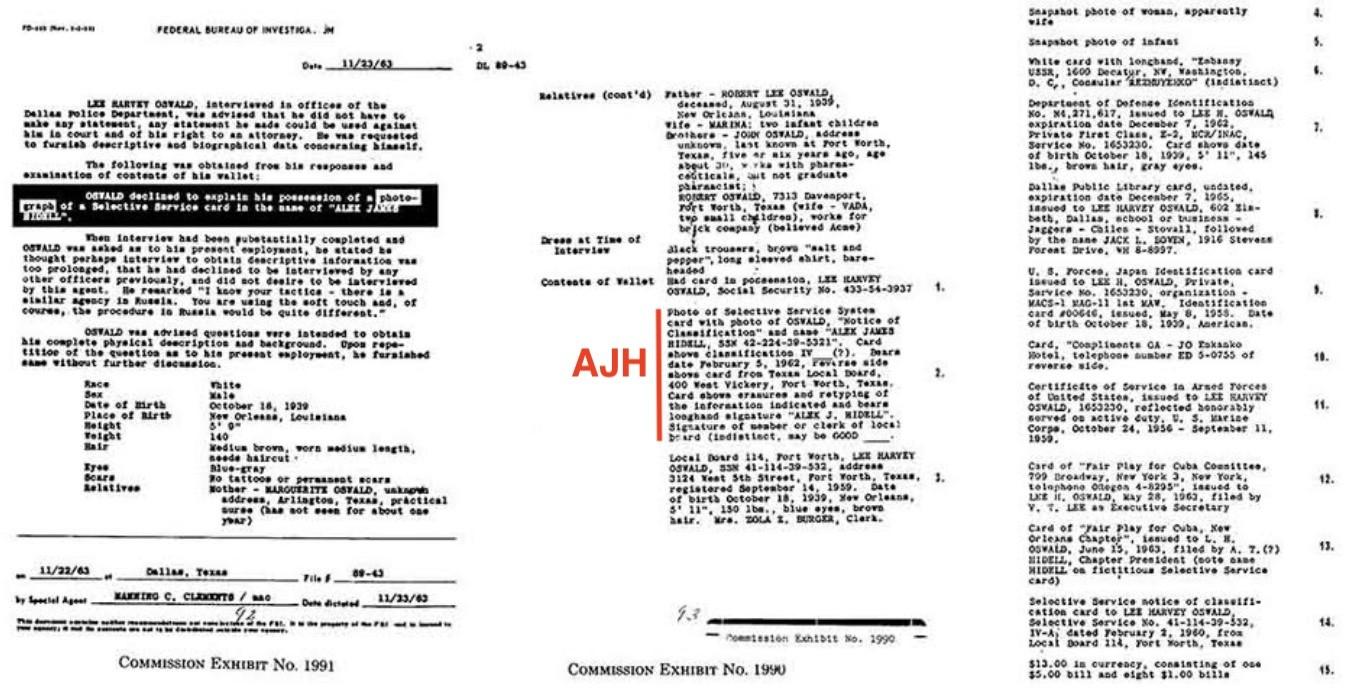
The 8 original items in Oswald's brown arrest
wallet,
in Dallas police headquarters at 2:00 PM on November 22, 1963, had
grown to 14 items when inspected and inventoried by FBI agent Manning
Clements eight hours later, at 10:00 PM. The addition of six "items
of evidence" was
accomplished while Oswald's arrest wallet was in Capt. Fritz's office.
In Clements' FBI report he listed 14 items found in Oswald's wallet and
$13.00 in currency (item #15). He listed one AleK James Hidell ID card
with Oswald's photo, which is noted in his FBI report (above) with a
vertical line in red, and he listed 6 military type cards with the name
Lee Harvey Oswald. A total of 14 items, but only one AleK James
Hidell ID card. The AleX James Hidell card was not in Oswald's
arrest wallet at 10:00 PM on November 22, 1963.


The AleK James Hidell ID card, shown above, came from the 2nd Oswald wallet at 10th & Patton, which was last seen in the possession of Capt. Westbrook. Eight hours later this card was "discovered" in Oswald's brown arrest wallet by Agent Clements at 10:00 PM. Clements told the Warren Commission, "I recognized it as being a fictitious card from the fact that the photograph was mounted on the card, and that there were erasures in typing of information on the card itself." This was likely the first and only time HARVEY Oswald saw the AleK James Hidell ID card with his photo. Oswald now knew that someone had put this card in his brown arrest wallet, but he didn't know why and declined to discuss this card with agent Clements. Clements told the Warren Commission that he showed Oswald the card but Oswald "declined to answer any questions as to the reason of his possession of it." The next morning, at 10:00 AM, Oswald was questioned by Capt. Fritz, who asked him about the AleK James Hidell ID card. Inspector Kelley wrote that Oswald refused to discuss the card.

The next day (Saturday) two more items were added to Oswald's arrest wallet, bringing the total number of items to 16. At 5:30 PM (November 23rd) Det. Sims, who worked for Capt. Fritz, gave 16 items from Oswald's arrest wallet to J.B. Hicks and requested 4 photos of each item. Capt. Fritz sent 16 items of evidence to be photographed, but photographs of 17 items were returned to Capt. Fritz.
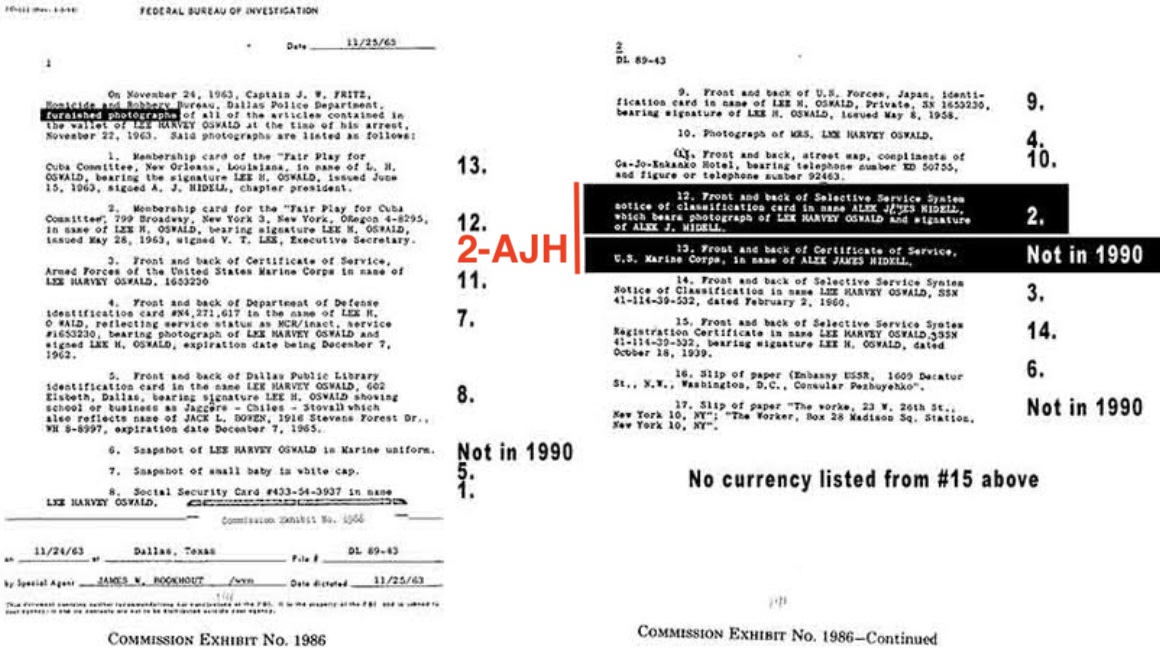
The following day, November 24, Fritz gave photographs of 17 items to FBI agent James Bookhout, identified in the FBI report above. Three items were added to the 14 items found by agent Clements in Oswald's arrest wallet. The items added were 1) a snapshot of Lee Harvey Oswald; 2) a Marine Corps Certificate of Service card with the name AleK James Hidell; 3) a slip of paper with the name and address of The Worker. This slip of paper connected HARVEY Oswald to the person in the backyard photo holding a rifle in his right hand and holding The Worker in his left hand. The total number of items in Oswald's arrest wallet was now 17. A careful reading of the list of items in Bookhout's report includes the AleK James Hidell card (with photo attached) that was originally listed in Agent Manny Clement's report of November 23, 1963. There is no mention of the AleX James Hidell card in Bookhout's report. The whereabouts of the AleX James Hidell ID card on November 24 is unknown and is not listed on any FBI report. The how, when, and where this card surfaced remains unknown, but it is listed on a DPD document.
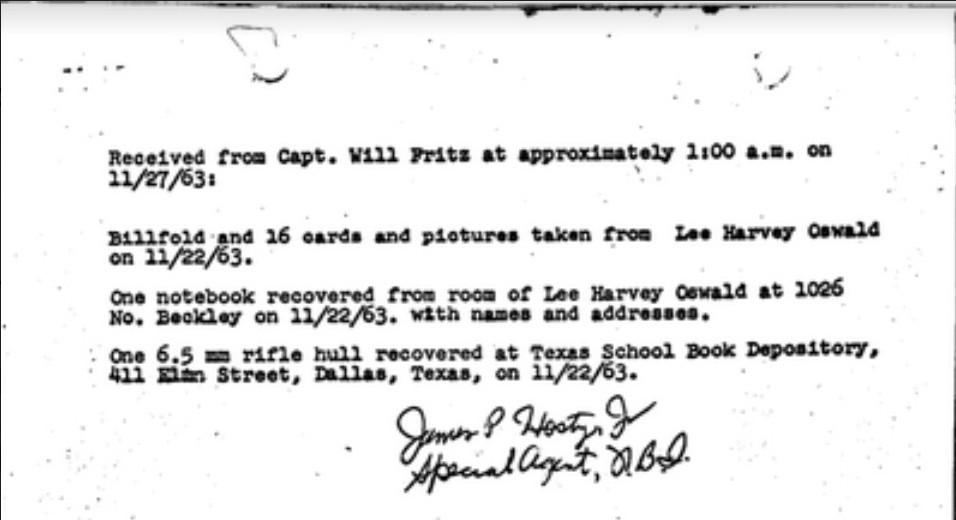
Four days later, on November 27, Capt. Fritz gave
FBI
agent James Hosty a total of 16 items from Oswald's wallet. One of the
items listed on Agent Bookhout's list of 17 items had been removed, but
there is no written inventory that would allow us to identify the
missing item. The missing item may have been the AleK James Hidell
ID card.
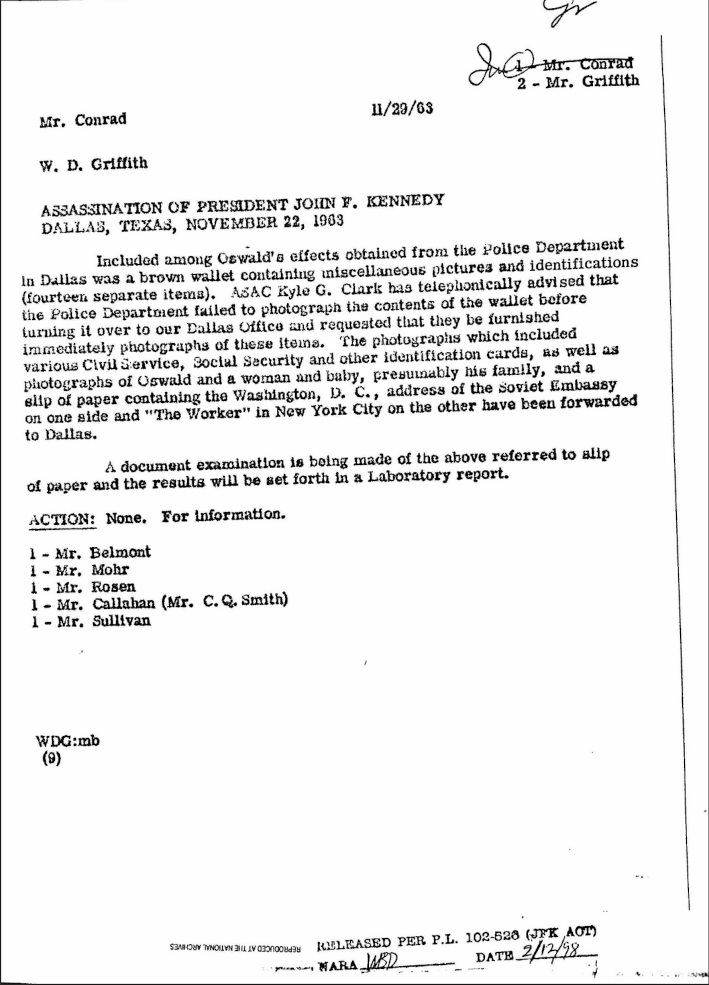

Two days later, on November 29, the FBI reported
they
received Oswald's brown arrest wallet and a total of 14 separate items
from the Dallas Police. This FBI memo claims the Dallas Police
Department "failed to photograph the contents of Oswald's wallet before
turning it over to the Dallas office," which was clearly not true. The
DPD gave FBI agent Hosty 16 items on November 27, but the FBI reported
receiving only 14 items. Two items are missing. It is worth
noting that in this FBI memo there is no mention whatsoever of the AleK
James Hidell ID card or the AleX James Hidell ID card. The two
missing items could be the AleK James Hidell and the AleX James Hidell
ID
cards.
We know the Dallas Police had possession of both the AleK James Hidell ID card and the AleX James Hidell ID card. These cards came from the 2nd Oswald wallet at 10th & Patton and were last seen in the possession of Capt. Westbrook.
We know the Dallas Police had possession of both the AleK James Hidell ID card and the AleX James Hidell ID card. These cards came from the 2nd Oswald wallet at 10th & Patton and were last seen in the possession of Capt. Westbrook.
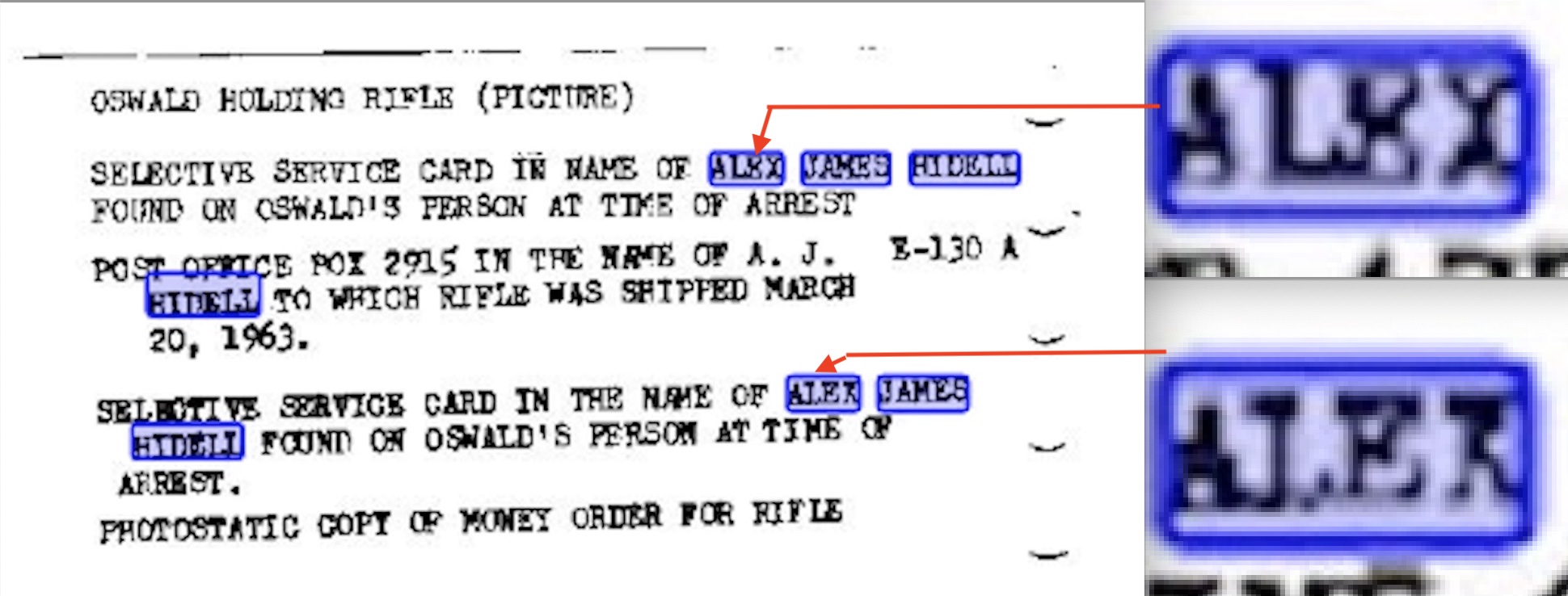
Both cards appear on records in the Dallas Police
Department, but only the AleK James Hidell card was found in Oswald's
wallet by Agent Manning Clements. How and when the AleX James Hidell
card became known to the DPD remains unknown (the document above is
from the Dallas Police files, identified as jfk.2950). The 2nd Oswald
wallet, last seen in the hands of Capt. Westbrook at 10th & Patton,
disappeared and was never seen again nor was it mentioned by anyone in
the Dallas Police.
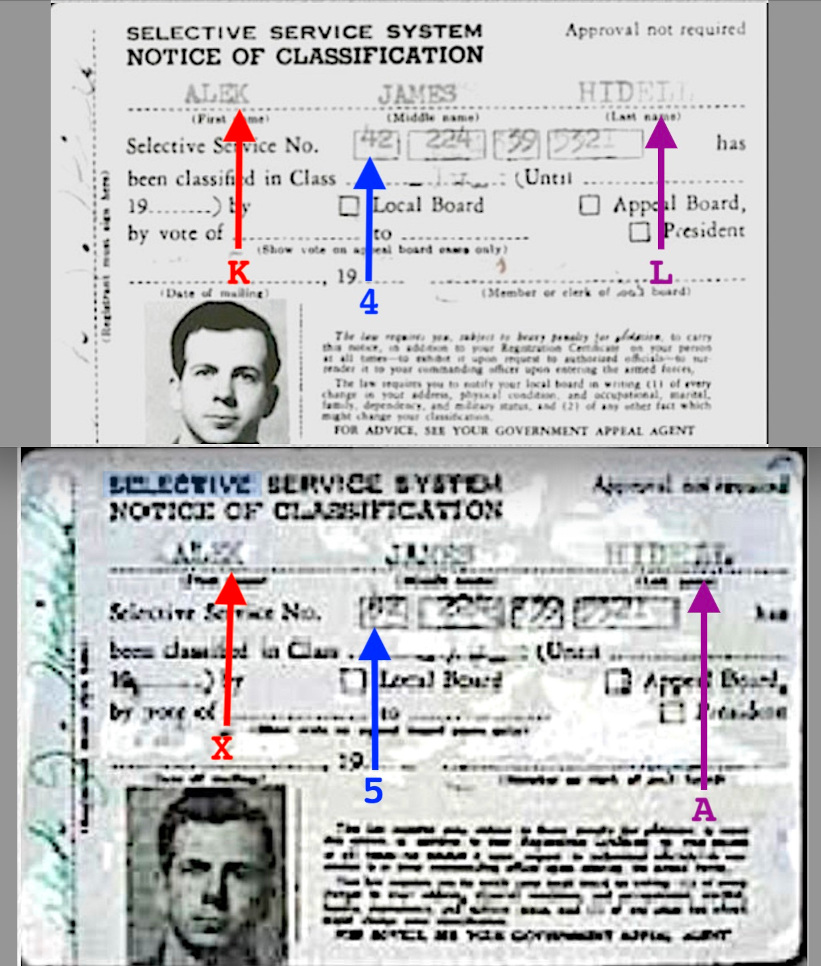
When the "AleK James Hidell" card (upper) and the "AleX James Hidell" card (lower) are shown together it is easy to see these are two different cards.
The National Archives and the FBI both reported there were 8 items of original evidence in Oswald's brown arrest wallet. On the evening of November 22, FBI Agent Manning Clements made a list of 14 items he found in Oswald's arrest wallet. The most important item added to Oswald's arrest wallet was the AleK James Hidell ID card, and it was added by someone in the Dallas Police Department. The following day (November 23rd) two additional items were added to Oswald's arrest wallet, making a total of 16 items. Fritz sent these 16 items to be photographed, but when returned to Fritz there were now 17 items--another item of evidence had been added to Oswald's wallet. On November 24th FBI agent James Bookhout wrote, "Captain J.W. Fritz....furnished photographs of all of the articles contained in the wallet of Lee Harvey Oswald at the time of his arrest." Bookhout's report listed 17 items from Oswald's arrest wallet. Three days later, on November 27, Fritz gave 16 items to FBI Agent James Hosty. On November 29 an FBI memo reported receiving 14 items of evidence and a brown wallet from the Dallas Police.
It is now clear that Items were added and deleted from Oswald's brown arrest wallet for the purpose of framing him for two murders of which he was innocent. However, the reader should also understand the importance of Mexico City as a staging area for the framing of Harvey Oswald in the assassination of President Kennedy. Heretofore, the emphasis has been placed on the alleged visits of Oswald to the Cuban and Soviet embassies. But the incident at the Hotel Luma in mid-summer, 1963, wherein Lee Harvey Oswald is being used to set up Harvey, reveals the actual workings of the framing with an imposter (LEE Oswald) using the alias "Alex James Hidell." At the same time HARVEY Oswald, living in New Orleans, was using the alias "A. Hidell" on his FPCC activities. During this time David Atlee Phllips was working at the Mexico City station of the CIA. According to his colleague, Winston Scott, Phillips' "comprehensive understanding of human beings combined with a thorough knowledge of covert action techniques and his fluent Spanish make him unusually valuable." Oswald, according to several accounts, was either working for or closely associated with the CIA. Therefore, it is reasonable to assume the name "AleK" was an alias used by HARVEY Oswald (first in the Soviet Union, then in Mexico City) while at the same time the name "AleX" (Hotel Luma) was an alias used by LEE Oswald. This would allow the CIA to monitor and follow the activities and whereabouts of both Harvey and Lee without exposing their true identities. The existing evidence points to Phillips exploring myriad ways of creating a false narrative of Oswald's nefarious purposes in the phony trip to Mexico City. The use of the identification cards of Alex and Alek Hidell is a perfect example of Phillips' stock-in-trade: misdirection and slight-of-hand in order to link Oswald to the mail order rifle that killed JFK. While the process may have been messy in switching the two ID cards from one wallet to another, the result was precisely what Phillips intended to achieve: the assigning of guilt to HARVEY Oswald and the confusion that would await investigators and researchers to make sense of the two names Alex and Alek Hidell.
Investigators and researchers have been trying to make sense of AleX and AleK Hidell for decades. Even today, 60 years later, when search the internet for a Selective Service card in the name of AleX James Hidell on GOOGLE, the only result is the name "AleK James Hidell." Phillips' misdirection and slight-of-hand concerning the use of alias' AleX and AleK Hidell continues to confuse researchers.
Oswald was returned to Fritz's office
Oswald was taken to a show-up at 7:40 pm and then returned to Fritz's office. While walking through the hallway Oswald told reporters. "They've taken me in because of the fact that I've lived in the Soviet Union," and then voiced his most famous statement to reporters, "I'm just a patsy." Later that evening Clements continued talking with Oswald for another hour. During his 3rd interrogation Oswald said, "I am waiting for someone to come forward to give me legal assistance."At 8:55 PM Det. Johnny Hicks and R.L Studebaker finger printed Oswald. When told to sign the fingerprint card Oswald said, "I will not sign the fingerprint card until I talk to my attorney." Barnes then made paraffin casts of Oswald's hands and the right side of his face.
During the evening of November 22 Michael Paine was shown one of the infamous backyard photographs and asked if he could identify the location of the house. Mr. Paine told the Warren Commission, "They asked me at first, the first night of the assassination if I could locate, identify the place where Lee was standing when he was holding this rifle and some, the picture on the cover of Life.....I identified the place by the fine clapboard structure of the house..... By the small clapboard structure; the house has an unusually small clapboard......The Neely Street address." Michael Paine's testimony is very significant, because according to the Dallas Police, the backyard photos were not found until the next day by Det. Rose and Stovall in Ruth Paine's garage. This photograph was not found by the Dallas Police at Oswald's rooming house or at Ruth Paine's in Irving, TX on November 22. Yet somehow, only hours after Oswald was arrested, the Dallas Police had possession of this photograph. This photo showed Oswald holding a rifle that was allegedly used to murder President Kennedy, a pistol that was allegedly used to murder officer Tippit, and in Oswald's left hand a copy of the communist newspaper The Worker. When shown this photo Oswald denied that he was the man in the photo. He said that someone had cut and pasted his face over the original face of the man in the photo. Neither the FBI, the Warren Commission, the HSCA, nor the ARRB showed any interest or attempt to determine how or when this photo was given to or created by the Dallas Police Department. This photo, on the cover of Life Magazine, helped to convince the public that Oswald was a communist who murdered President Kennedy and officer Tippit.
In the author's opinion the man in this photo is Roscoe White, a skilled photographer who was working for the Dallas Police. On his right hand, close to his wrist, there appears a nodule that was sustained by an injury that occurred when White was stationed at Ft. Sill, OK.
Robert Hester and his wife Patricia worked for the National Photo Laboratory in the Dallas. On the evening of November 22nd the Hesters worked throughout most of the night developing film and printing photographs. Both of the Hesters said they saw the "backyard photographs" in the hands of the FBI. Robert said that he saw a color transparency of one backyard photos and another photo in which there was no image of Oswald-only the backyard. Both Michael Paine and the Hester's saw one or more backyard photos during the evening of November 22. However, the Dallas Police first found the backyard photos in Ruth Paine's garage the following day.
American Civil Liberties Union attorney Greg Olds told the Warren Commission that at 10:30 PM on Friday night he received a phone call from one of his board members. The member said that Oswald was quoted as saying he had not been given the opportunity to have counsel, and suggested to Mr. Olds that he check into this matter. Olds then called the police department and finally talked to Captain Fritz who said, "No, Oswald had been given the opportunity and declined." Warren Commission attorney Stern asked Olds, "Did Captain Fritz say that Oswald did not want counsel at that time, or that he was trying to obtain his own counsel?" Olds replied, "What I was told, that he had been given the opportunity and had not made any requests." Capt. Fritz lied to the Warren Commission. By 10:30 on Friday night Oswald had already made several requests for an attorney.
At 11:00 PM, November 22, Manny Clements resumed his questioning of Oswald and was joined by police Detectives John Adamcik and L.D. Montgomery. Oswald told the investigators that he had lived in Russia and that he liked it there. After answering more questions Oswald said, "I think I have talked long enough. I don't have anything else to say.....what started out to be a short interrogation turned out to be rather lengthy.... I don't care to talk anymore.... I am waiting for someone to come forward and give me legal assistance.
Around 11:15 PM Jack Ruby arrived at police headquarters and had no trouble gaining access. He was seen by United Press photographer Pete Fisher standing in the show-up room in the basement a few minutes before Oswald was brought in by the police. Oswald was escorted into the assembly room and passed within three feet of Ruby. District Attorney Henry Wade read a prepared statement about Oswald's background. When Wade incorrectly named the Cuban organization to which Oswald belonged, Ruby corrected Wade and said, "That's the Fair Play for Cuba Committee, Henry."
At 12:10 AM, November 23rd, Oswald was taken to the stage in front of the show up room where he talked with the press for about 5 minutes. Oswald told reporters, "I positively know nothing about this situation here. I would like to have legal representation. I was questioned by a judge and I protested at that time that I was not allowed legal representation during that short and sweet hearing. I really don't know what this situation is about. Nobody has told me anything except that I have been accused of murdering a policeman. I know nothing more than that and I do request that someone to come forward and to give me a legal assistance." A reporter asked, "Did you kill the President?" Oswald replied, "No, I have not been charged with that. In fact, nobody has said that to me yet. The first thing I heard about it was when the newspaper reporters in the hall asked me that question." Dallas Police Chief Jesse Curry said, "You have been charged." As he was being led away by police Oswald said, "I did not do it. I did not do it. I did not shoot anyone." Oswald was taken to his jail cell on the 5th floor.
At 1:30 AM on November 23rd Oswald was removed from his jail cell and taken to the identification bureau on the fourth floor. When Oswald saw Justice of the Peace David Johnston he said,"What's the idea of this. What are you doing this for. Well, sir, I guess this is the trial....I want to contact my lawyer, Mr. Abt, in New York City. I would like to have this gentleman. He is with the American Civil Liberties Union." Oswald was then arraigned by Johnston, this time for the murder with malice of President Kennedy. At the end of Oswald's arraignment he said "I don't know what you're talking about. That's ridiculous." Oswald was returned to his jail cell on the 5th floor.
On Saturday morning, at 10:30 AM, Detectives Sims and Boyd checked Oswald out of jail and brought him to Captain Fritz's office. SS Inspector Kelley wrote, "Fritz showed Oswald a Selective Service card that was taken out of his wallet which bore the name of Alex Hidell. Oswald refused to discuss this after being asked for an explanation of it, both by Fritz and by FBI agent James Bookhout." Secret Service Inspector James Kelley wrote, "Oswald refused to discuss the card, denied that he brought a package to work on that day, and denied that he had ever had any conversation about curtain rods with the boy named Wesley Frazier who drove him to his employment." Fritz asked Oswald what he thought of President Kennedy and his family. Oswald said he didn't have any views on the President. He said, "My wife and I like the President's family very well. They are interesting people."
Inspector Kelley asked Oswald if he shot the President and he said he had not. He asked Oswald if he had shot Governor Connally and he said he had not. Oswald said that he did not intend to answer any further questions without counsel and that if he could not get Abt, then he would hope that the Civil Liberties Union would give him an attorney. Boyd and Sims returned Oswald to his cell at 11:33 am.
Around 12:30 PM, November 23rd, Jack Ruby telephoned KLIF radio in Dallas and spoke with Kenneth L. Dowe. Ruby asked Dowe if he had any information as to when Lee Harvey Oswald was going to be transferred to the county jail.
At 12:35 PM Oswald was brought to Captain Fritz's office where Fritz asked him about the backyard photograph. Oswald said he had never seen this photo. He said the photo was a fake, and that someone had superimposed his face on the body of an unknown person.
Around 4:00 PM Chief Curry asked Fritz if he was finished questioning Oswald so that he could arrange for his transfer to the county jail. When Fritz said that he wanted to question Oswald again at 6:00 pm, Curry suggested that Oswald be moved late in the night. Fritz rejected the idea fearing that assailants could attack Oswald under the cover of darkness. Curry and Fritz then agreed to transfer Oswald the following morning at 10:00 AM.
At 5:30 PM Mr. H. Louis Nichols, President of the Dallas Bar Association, visited Oswald in his cell at the Dallas jail. Nichols said, "l asked him if he had a lawyer and he said, 'Well, he really didn't know what it was all about, that he was-he had been incarcerated, and kept incommunicado.' Nichols said, Well, I have come up to see whether or not you want a lawyer." Nichols recalled, ".....he asked me first did I know a lawyer in New York named John Abt.... .l didn't know him and he said, 'Well, I would like to have him represent me' .....Then he asked me if I knew any lawyers who were members of the American Civil Liberties Union.....'Either Mr. Abt or someone who is a member of the American Civil Liberties Union' .... .l said, 'What I am interested in knowing is right now, do you want me or the Dallas Bar Association to try to get you a lawyer?' ..... He said, 'No, not now.....You might come back next week, and if I don't get some of these people to as assist me, I might ask you to get somebody to represent me. "'
At 6:00 PM Oswald was brought to Fritz's office. Fritz said, "When I told him that the backyard picture was recovered from Mrs. Paine's garage, he said that picture had never been in his possession, and I explained to him that it was an enlargement of the small picture obtained in the search. At that time I showed him the smaller picture. He denied ever seeing that picture and said that he knew all about photography, that he had done a lot of work in photography himself, that the small picture was a reduced picture of the large picture, and had been made by some person unknown to him. He told me that he understood photography real well, and that in time, he would be able to show that it was not his picture, and that it had been made by someone else." Oswald, though slightly shaken by the photograph, kept his composure and repeatedly said the photo was a fake. At 7:15 PM Oswald was taken to jail on the 5th floor.
At 8:00 PM, November 23rd, Oswald was allowed to use the telephone. He spoke for about 30 minutes while officer J. L Popplewell stood nearby. Curiously, there are no police telephone logs to identify the telephone number which Oswald called or the party with whom he spoke for 30 minutes. A 30 minute phone call by the accused assassin of the President of the United States could have been extremely important. It appears the people monitoring, and perhaps recording Oswald's phone call, wanted the identity of the caller and the substance of the conversation kept secret.
At 2:30 AM on Sunday morning an unknown individual telephoned the Dallas FBI office. The caller said, "I represent a committee that is neither right nor left wing and tonight, tomorrow morning, or tomorrow night, we are going to kill the man that killed the President. There will be no excitement and we will kill him. We wanted to be sure and tell the FBI, Police Department, and Sheriff's Office, and we will be there and we will kill him." The man who took the call, Vernon Glossup, immediately prepared a memorandum which he furnished to FBI agent Milton Newsom who in turn furnished the information to the Dallas County Sheriff's office and to the Dallas Police Department.
Deputy McCoy, of the Dallas County Sheriff's office, received a call from a man who said he was a member of a group of one hundred people. The man wanted the Sheriff's office to know that they had voted one hundred percent to kill Oswald while he was in the process of being transferred to the county jail. He wanted to inform the Sheriff's department so that none of the Deputies would get hurt.
At 3:00 AM Dallas Police Officer Billy Grammer received a phone call from a familiar voice warning him that Oswald would be killed if the police didn't transfer him in secret. Grammer was home the next morning watching Oswald's transfer on television when he saw his friend, Jack Ruby, shoot Oswald. He instantly remembered the call from the previous night and realized the caller was Ruby. Grammer gave a sworn affidavit to the Dallas Police but was never asked to testify before the Warren Commission. There is a very good interview of Billy Grammer that can be seen on YouTube.
NOTE: Within an hour, between 2:00 AM and 3:00 AM someone, almost certainly Jack Ruby, called the FBI, Dallas Sheriff, and the Dallas Police and told them Oswald would be killed if he was not transferred in secret. The man who placed these calls was probably trying to get the police to transfer Oswald in secret so that he would not have to kill Oswald as ordered.At 3:45 AM FBI agent Newsom called Dallas Police Captain W.B. Frazier and told him about the anonymous call in which the individual said a group of people was going to kill Lee Harvey Oswald that night or the following day and there was nothing that any one could do about it. Frazier telephoned Captain Fritz at 5:00am and relayed the information to him.
Around 7:00 AM Jack Ruby parked his 1960 Oldsmobile at the Allright Parking Lot at the corner of Main and Pearl Streets across from the Western Union Building near the
police station.
At 8:00 AM John A. Smith, of WBAP-TV, saw Jack Ruby standing on the sidewalk next to the police station on Commerce Street. Smith said that about 8:10 AM Ruby walked over to his truck and asked, "Have they brought Oswald down yet?" Smith said the next time he saw Ruby was about 10:00 AM, standing on the sidewalk on the Commerce Street side of the Police station next to the ramp leading to the basement.
At 9:30 AM Oswald was interrogated for the last time. Captain Fritz began the session by once again asking Oswald to identify the place where the "backyard photographs" had been taken, but Oswald refused to discuss the matter. Fritz then asked Oswald if he was a communist and he replied, "No, I am a Marxist but I am not a Marxist-Leninist." Oswald told Fritz that he became interested in the FPCC while in New Orleans and said that he was the local secretary, but the group had no officers.
When asked if he received a rifle addressed to "A. Hidell" at PO Box 2915 Oswald replied "absolutely not." Oswald denied emphatically that he ever ordered a rifle under his name or any other name, and denied that he allowed anyone else to order a rifle through his box. He also denied that he ordered a rifle by mail or purchased a money order for the purpose of paying for a rifle. Oswald told Fritz, "How could I afford to order a rifle on my salary of $1.25 an hour when I can't hardly feed myself on what I make."
Postal Inspector Harry Holmes asked Oswald who A.J. Hidell was and Oswald replied, "I don't know any such person." Fritz interrupted and said, "What about this card we got out of your billfold? Oswald replied, "Now I have told you all I am going to tell you about the card in my billfold. You have the card yourself, and you know as much about it as I do."
After Captain Fritz terminated the interview at 11:15 AM Secret Service Inspector Thomas Kelley tried to speak with Oswald, alone, before his transfer. Kelley wrote in his report, ''He said that he would be glad to discuss this proposition with his attorney and that after he talked to one, we could either discuss it with him or discuss it with his attorney, if the attorney thought it was the wise thing to do, but that at the present time he had nothing more to say to me.
Harvey Oswald was handed articles of clothing which consisted of trousers, shirts, and a couple of sweaters. When asked if he wanted to change clothes before his transfer to the county jail Oswald said, "Just give me one of those sweaters." He didn't like the first one handed to him and insisted on wearing a black pullover sweater. The police removed one handcuff while he slipped the sweater over his head and then the other handcuff. Before leaving Fritz's office Oswald was asked if he wanted to hide or cover his face or wear a hat, but he refused.
Harvey Oswald allegedly told Captain Fritz there was a conspiracy, but he was ignored. He told Fritz the backyard photos were fakes, but he was ignored. When Oswald said, "I'm just a patsy," he was ignored by most people. When he remarked, "Now everyone will know who I am," he knew his work as a government informant was finished, but his remark was ignored.
Harvey Oswald, double-crossed and sitting in the Dallas jail, posed a serious threat to the conspirators. After Oswald was asked by Capt. Fritz about an Alek Hidell ID card with his photo, and then asked if he received a rifle addressed to A. Hidell, and then shown a photo of him holding a rifle, Oswald knew for a fact that someone was setting him up to take the blame for killing President Kennedy.
HARVEY Oswald was part of a multi-year super-secret project developed by the CIA in which two people shared the name Lee Harvey Oswald. The purpose of this project was to infiltrate the Russian speaking Harvey Oswald into the Soviet Union as a spy. Oswald's true identity, his nationality, and the "Oswald Project" were some of the CIA's most closely guarded secrets. His involvement with US intelligence agencies linked him directly to the most sensitive operation ever conducted by the CIA-the assassination of a US President. Senator Richard Schweiker, who originally chaired the House Select Committee until forced out by CIA interests, was correct when he said, "Oswald had the fingerprints of intelligence all over him." I believe that Oswald, in desperation, may have been close to telling the press about his connections with the FBI and CIA. But the conspirators knew that Oswald's involvement and knowledge had to remain hidden from the public, no matter what the cost. Harvey Oswald could never be allowed to go to trial.
Jack Ruby
On May 28, 1943 Jack Rubenstein enlisted in the Army Air Corps. Ruby was "officially" an aircraft mechanic in the Army Air Corps from May 1943 until February 1946 at various bases in the South. However, his real assignments were related to counterintelligence. Ruby was first assigned to Keesler Field, in Mississippi. During the summer of 1943, while in the Army, Rubenstein attended the first of several communist party meetings on the third floor of a commercial building on Walnut Street in Muncie, Indiana.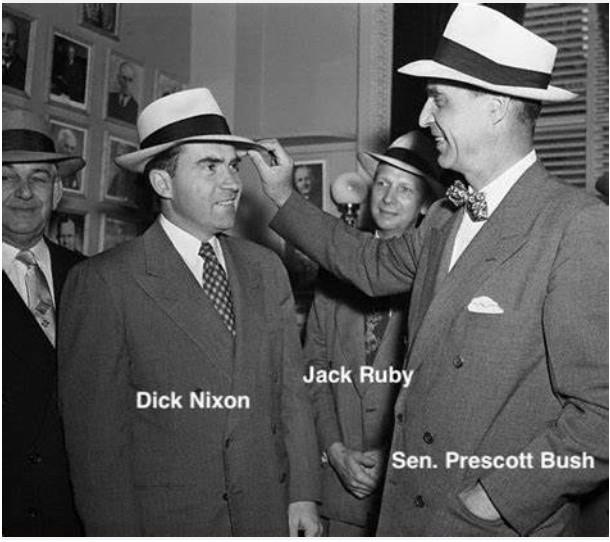
Ruby's work as an undercover informant, while in the Army Air Corps, likely continued when he worked for the House UnAmerican Activities Committee (HUAC) and reported on Communist Party activities. A memorandum written by a staff assistant on November 24, 1947 reads, "It is my sworn statement that one Jack Rubenstein of Chicago noted as a potential witness for hearings of the House Committee on UnAmerican Activities is performing information functions for the staff of Congressman Richard M. Nixon of California. It is requested Rubenstein not be called for open testimony in those hearings. In addition to his undercover work for the Army Air Corps and the HUAC, Ruby was also an undercover informant for the Federal Bureau of Narcotics.
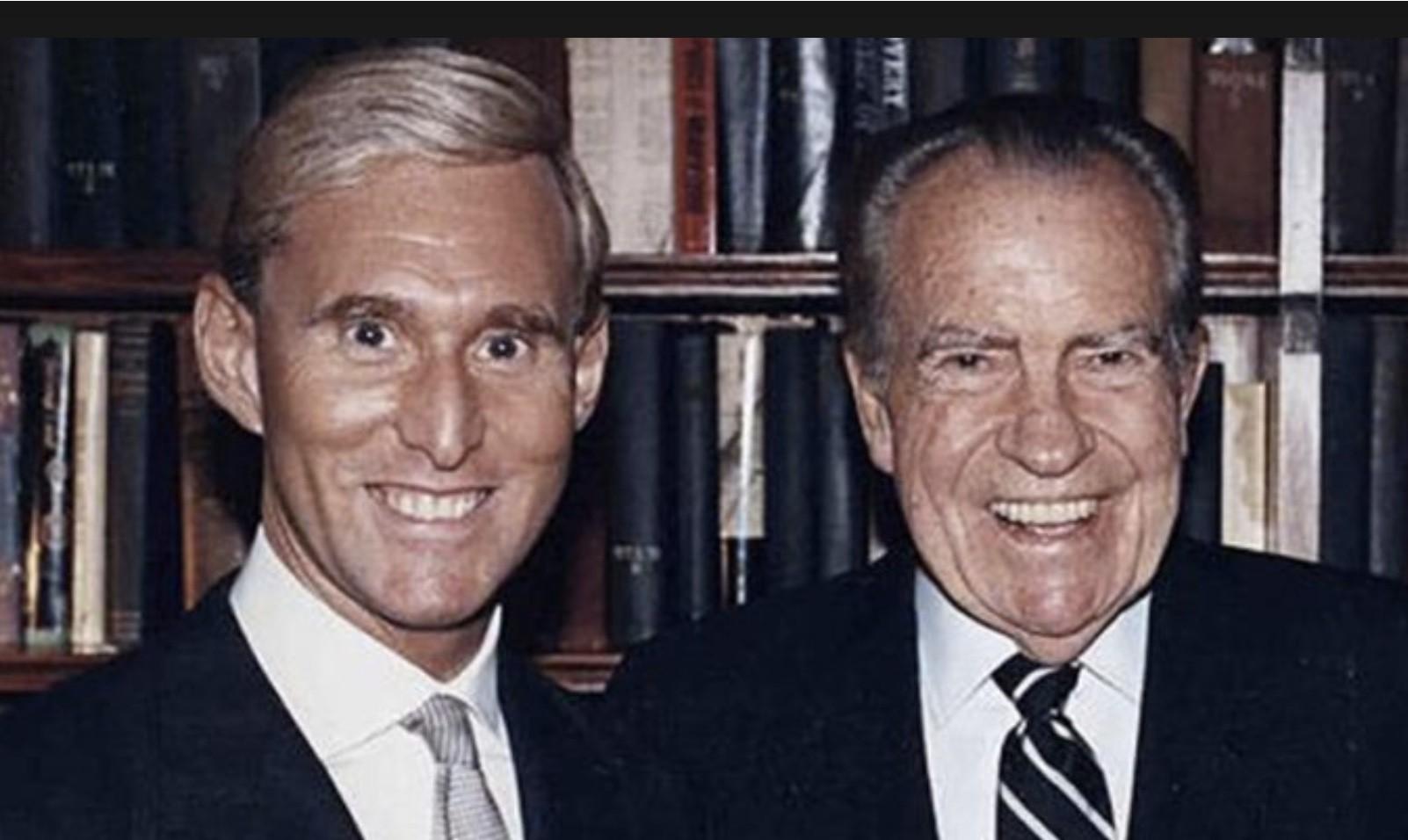
In 1982 Richard Nixon told his former aide and confidante Roger Stone, "The damn thing is, I knew this Jack Ruby. Murray Chotiner brought him to me in 1947, said he was one of 'Johnson's boys' and that LBJ wanted us to hire him as an informant for the Committee. We did."
In 1952 Jack Ruby began commuting from Dallas to Daytona, Florida where he became involved in supplying counterfeit currency, guns, and munitions to leftist rebels in Cuba. Ruby soon became acquainted with former Cuban President Carlos Prio and CIA operative Donald Edward Browder. The men contracted with Joe Marrs, of Marrs Aircraft, to transport weapons and munitions to Cuba. Ruby soon purchased an interest in two aircraft that he used to transport the arms, and also acquired partial ownership in a Havana gaming house in which Prio held majority ownership. Donald Browder knew Jack Ruby well and said, "During the pre-Castro years, prior to 1959, Customs would not oppose gun shipments to Castro."
In May, 1954 Prio and seventeen other persons were indicted on charges stemming from their purchase, exportation, and transportation of arms and munitions to Cuba. Prio did not contest the charges and was fined a mere $9,000. Jack Ruby, Prio's business partner and gun-running accomplice, was not charged nor even questioned by US authorities.

In 1957 Robert McKeown lost his manufacturing business in Cuba. By this time Prio, McKeown, and Jack Ruby had known each other for 5 years. But it was McKeown who began to develop a close, personal friendship with Castro as he delivered boatload after boatload of arms and munitions to Castro. McKeown was always paid with $100 bills bundled in paper wrapping marked "Pan American Bank, Miami." Ruby was commuting between Dallas and the Houston waterfront community of Kemah, TX. James E. Beaird, a poker playing friend of Ruby's, told both The Dallas Morning News and the FBI that Ruby used to store guns and ammunition in a two-story house between the waterfront and railroad tracks in Kemah, TX., in Galveston Bay. On the weekends Beaird personally saw Ruby and his associates load "many boxes of new guns, including automatic rifles and handguns" onto a 50-foot long military-surplus boat. It was Robert McKeown who often piloted the boat to a drop-off point in Mexico, where Castro himself would land his yacht, the Granma, and pick up the arms.

In 1958 the Oklahoma State Crime Commission linked "Abe Rubenstein," owner of a night club in Dallas, to a carload of guns and ammunition destined for Cuba. Also In 1958 "Jack Rubenstein"wrote a letter to the Office of Munitions Controls requesting permission to negotiate the purchase of firearms and ammunition from an Italian firm. Ruby never seemed concerned about his gun-running activities.
On March 15, 1959 Ruby telephoned and met with CIA-connected gun-runner Thomas Eli Davis in Beaumont, TX. Soon, Ruby and Davis were supplying arms and munitions to anti-Castro Cubans, apparently without the fear of arrest. While on trial for murdering Oswald, Ruby told his attorney, Tom Howard, that "he had been involved with Davis, who was a CIA connected gunrunner entangled in anti-Castro efforts" and that he, Ruby, had intended to "begin a regular gun-running business with Davis." Ruby warned Howard about this connection, and feared that if it were to be revealed by either an investigative reporter or a witness it would blow open the CIA's role in the JFK assassination.
In 1959 Cuban travel records show that Jack Ruby entered Cuba from New Orleans on August 8, left Cuba on September 11, re-entered Cuba on September 12, and returned from Cuba to New Orleans on September 13, 1959.
In 1961 Ruby was involved in a plan to sell British Enfield rifles to anti-Castro-Cubans in Florida. Nancy Perrin Rich told the Warren Commission about a group running Enfield rifles from Mexico to Cuba in 1961 and returning with Cuban refugees to Florida. During the 10 years preceding the assassination of President Kennedy there is a considerable amount of information that shows the FBI, CIA, and US Customs were very familiar with "Jack Rubenstein"and his gun-running activities. The Warren Commission requested a written response from the CIA for any and all "information on Jack Ruby, aka Jack Rubenstein." The CIA responded by stating, "Examination of CIA records failed to produce information on Jack Ruby or his activities," but the CIA provided no information whatsoever for "Jack Rubenstein."
In the Spring of 1961, while HARVEY Oswald was living in Russia, Sheriff Thompson, of Monroe County, Florida, Key West, recalled that "LEE Oswald" fueled up his boat in Key West shortly after the Bay of Pigs invasion. Oswald didn't have the funds to pay for the fuel and telephoned someone in Dallas, Texas. Within two hours a man named "Ruben" arrived and paid for the fuel.
In 1961 William Huffman was the attendant on duty at the Sands Marine Fueling Station at Stock Island, Key West, Florida. LEE Oswald, accompanied by four or five Cubans, docked a 43-foot Chris Craft boat and filled up with diesel fuel. Huffman recalled that Oswald did not have enough money to pay for the fuel, made a phone call, and soon a man named "Ruben" arrived and paid for the fuel.
On April 11, 1962 Jack Ruby and LEE Oswald were together at the Escapades Lounge, 3300 Old Spanish Trail, in Houston, TX. Robert Allen Price told the House Select Committee that he went to the lounge to visit his wife, Dolores, who was the day manager. In the afternoon four men came into the lounge and Mary, one of the waitresses, yelled "Jack Ruby," whom she knew from Dallas. Introductions were made and Ruby said that he and his friends were "killing time"until "plane time." Ruby said they were leaving from Alvin, TX at 6:30 PM and flying to Cuba.
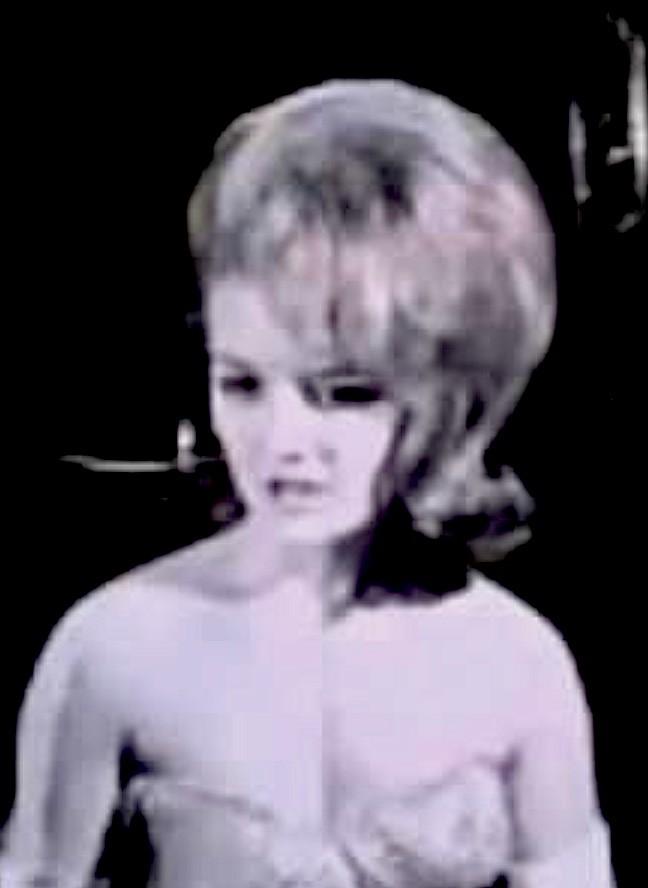
On November 24, 1963, one of Ruby's dancers, Karen Carlin, aka "Little Lynn," told U.S. Secret Service agent Roger Warner that she "was under the impression that Lee Harvey Oswald, Jack Ruby, and other individuals unknown to her, were involved in a plot to assassinate President Kennedy and that she would be killed if she gave any information to authorities." Lynn reportedly died of a gunshot wound in Houston in 1964.
On Labor Day weekend, 1963, HARVEY Oswald, a very pregnant Marina, and 2-year old June, boarded a city bus in New Orleans and rode to the Murrets. Three hundred and fifty miles west, in Kemah, TX, Robert McKeown watched as a car arrived, parked, and two men got out and walked toward his home. One of the men introduced himself to McKeown as LEE Oswald, and said that he wanted to purchase rifles. McKeown, who was still on a 5-year probation for running guns to Cuba, refused to sell guns to LEE Oswald. The two men left but returned a few minutes later and LEE Oswald once again asked McKeown to sell him rifles, but McKeown refused.
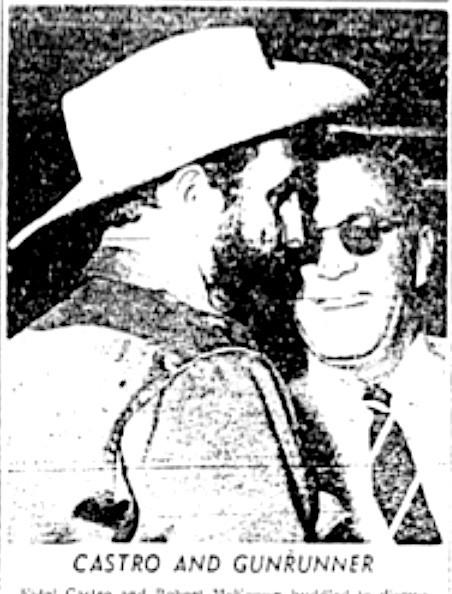
LEE Oswald's attempt to purchase rifles from Robert McKeown, who was a very close personal friend of Fidel Castro, was very significant and an obvious attempt by the conspirators to link Lee HARVEY Oswald to Cuba.
This "staged encounter,"in which LEE Oswald impersonated HARVEY Oswald, was the first in a series of attempts to frame/set-up HARVEY Oswald as the future assassin of President Kennedy. If McKeown had sold one or more rifles to LEE Oswald then one of those rifles would have been "planted"on the 6th floor of the TSBD, found by police, and linked HARVEY Oswald to McKeown, Castro, and Cuba . The American public would have been outraged and would have demanded a retaliatory response against Cuba by US armed forces.
During the first week of September, Louisiana gubernatorial candidate Clyde Johnson was residing temporarily at the Roosevelt Hotel in New Orleans. A man telephoned Johnson, introduced himself as Alton Bernard, and asked to meet with him. Johnson agreed and soon Bernard, accompanied by a young man named "Leon,"arrived at Johnson's hotel room. About 10 minutes later a third man arrived and was introduced as "Jack." Johnson watched as Mr. Bernard opened his briefcase and handed thick, brown envelopes to Jack, Leon and to himself. The envelope given to Johnson contained $5000 in cash, for his gubernatorial campaign. After the assassination of President Kennedy, Johnson identified "Leon"as Lee Harvey Oswald and "Jack"as Jack Ruby. Years later Johnson identified a photograph of Clay Shaw as the man who introduced himself as "Alton Bernard" at the Roosevelt Hotel. Gubernatorial candidate Clyde Johnson was a very credible witness who met Clay Shaw, Jack Ruby and LEE Harvey Oswald in the summer of 1963. Johnson was scheduled to testify at Clay Shaw's trial in New Orleans, but was badly beaten and unable to appear. A short while later he was murdered by a shotgun blast.
Mort Benjamin, a Federal Bureau of Narcotics agent in New York, found a file showing that Jack Ruby had been a government informer since the 1940s.
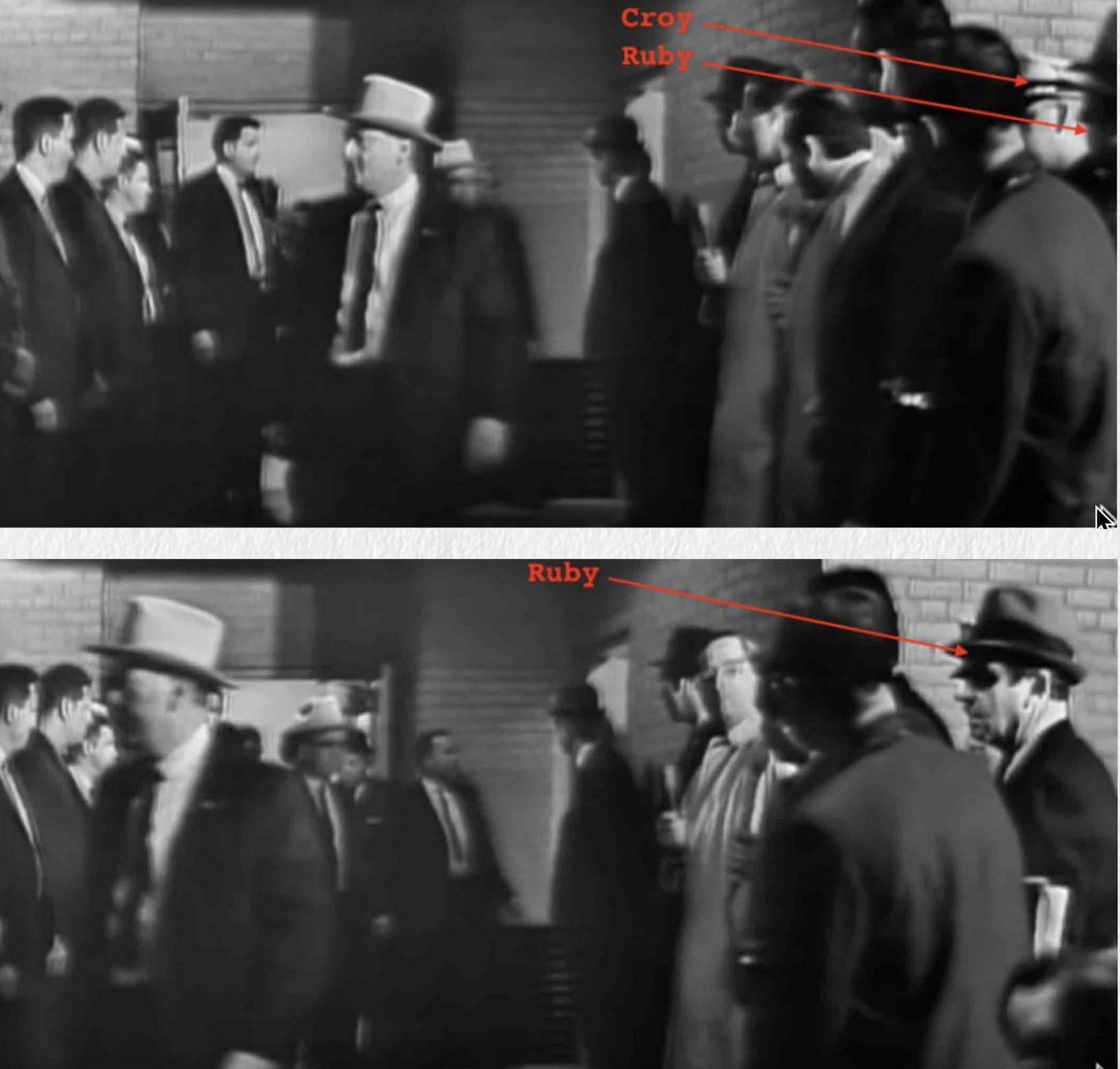
On Sunday, November 24, Ruby got into the basement of City Hall and shot and killed HARVEY Oswald. The author believes that Ruby had help from Westbrook and Croy getting into the basement within one minute of when Oswald appeared. In these photos Croy, wearing a white police hat, is standing next to Ruby moments before Ruby murdered Oswald. People can read about Oswald's murder HERE on this website.
When Ruby was interviewed by reporters, during his trial for killing Oswald, he said the following:
"I'm the only one in the background that knows the truth. Everything pertaining to what's happening has never come to the surface. The world will never know the true facts of what occurred, my motive. The people had to much to gain and had such an alterior motive for putting me in the position I'm in, will never let the true facts come above board to the world."
A reporter asked, "Are these people in very high positions Jack?"
Ruby replied, "Yes."